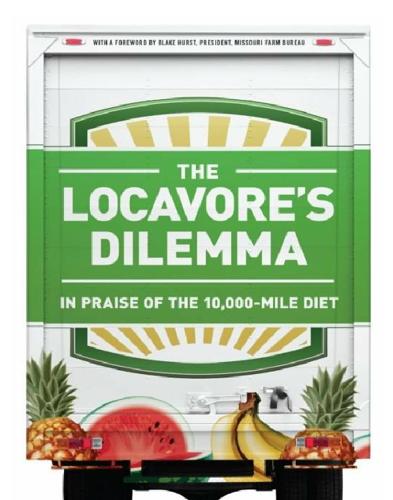
The Locavore's Dilemma
by
Pierre Desrochers
and
Hiroko Shimizu
Published 29 May 2012
Los Angeles Times (March 9) http://articles.latimes.com/2008/mar/09/local/me-market9. 24 Some farm-to-institution programs (such as farm-to-school http://www.farmtoschool.org/) also operate on the same model and can be subjected to the same kind of criticism we raise for CSA initiatives. 25 Patti Ghezzi. 2009. “The Tasty Advantages of Community Supported Agriculture.” Divine Caroline http://www.divinecaroline.com/22145/70730-tasty-advantages-community-supported-agriculture. 26 Lynda Altman. 2001. “Pros and Cons of Community Supported Agriculture. CSAs are not for everyone” Associate Content from Yahoo.com (February 15) http://www.associatedcontent.com/article/7734092/pros_and_cons_of_consumer_supported.html?cat=6 . 27 Adapted from the Tucson Community Supported Agriculture initiative website http://www.tucsoncsa.org/about/why-you-should-join/. 28 Gary Blumenthal. 2011.
…
Food Inc. was nominated for an Academy Award and has become part of the curriculum for an untold number of college courses. Everybody that matters advises me to find a farmers’ market and set up a stall. I should concentrate on marketing directly to consumers, including computing the food miles I have to travel to reach that market. Perhaps Community Supported Agriculture (CSA) would be just the thing—I’ll arrive on your front porch once a month, with corn, soybeans, and maybe even a geranium or two. There is a problem with this plan. “Think local” may be what the culture prescribes, but the market is sending a markedly different message. Farm income was up 28% in 2010, topping 100 billion dollars for the first time.
…
The issue was given some prominence a few years ago at the renowned Santa Monica Farmers’ Market in southern California when home cooks began to complain that purchasers employed by local high-end restaurants would show up at the crack of dawn and quickly whisk away the best of the most exotic produce. Soon after, produce companies did the local chefs one better by ordering items in advance and selling them to high-end restaurants and markets across the country.23 Even more problematic are community-supported agriculture (CSA) initiatives.24 In such schemes, farmers who grow food and a group of individuals who decide to support them agree on advanced purchases of items such as vegetables, fruits, meat, eggs, cheese, honey, and frozen produce off-season. Depending on the nature of the arrangement and prices paid, the participating farmer will offer a selection of seasonal items at regular intervals (typically once a week) and either deliver them to consumers’ doors or arrange for pickup at a central location or at the farm (sometimes with additional work being done by the purchaser).

The new village green: living light, living local, living large
by
Stephen Morris
Published 1 Sep 2007
In 1965 Japanese women initiated a direct, cooperative relationship in which local farmers were supported by consumers on an annual basis. Community Supported Agriculture continues to blossom in North America, and it opens various doors of opportunity everyday for local communities, helping them get back in touch with each other. In a CSA environment, this is possible in many ways: quite simply, the shareholders physically get together at pick-up, socially interact with one another and the farmer(s), and provide economic support for their neighbors, thanks to one thing that every single living person has in common with the next: eating. Resources Robyn Van En, Basic Formula to Create Community Supported Agriculture, CSANA Indian Line Farm, 1988.
…
(Bill McKibben) .....................................67 4 : The End of Nature Slow Food Movement Has Global Outreach ......................................81 review of Look Homeward, America (Bill Kaufmann) .....................84 Swami Calls for an Up-Wising (Swami Beyondanada)........................86 Float Like a Butterfly (Julia Butterfly Hill) ..........................................91 5: One-Straw Revolution Clean the Air in your Home with Houseplants (Bill Wolverton) ......103 Too Good to Throw Away (Josh Wachtel) ........................................107 The Rise and Fall of Raw Milk (Ron Schmid)...................................117 6 : Small is Beautiful What is Community Supported Agriculture (Robyn Van En) ...........129 Community Supported Energy 101 (Greg Pahl) ..............................132 Friends Meeting (Dave Smith) .........................................................135 Memoirs of a Moderator (John McClaughry)...................................138 Think Clean,Think Green (Cara Matthews).....................................141 Neighborhood into an Eco-Hood!
…
Deep ecology reinforces that idea with a sense of the holiness and specialness of all life in full diversity, an understanding that both human and non-human well-being are equally valuable, and a charge that humans must live lightly on the land, using its life systems and fellow creatures only as necessary for our frugal survival.These ideas in tandem provide the only sensible way for humans to live, long-term, on earth.” — Kirkpatrick Sale Middlebury College 128 chapter 6 : Small is Beautiful What is Community Supported Agriculture (CSA)? C by Robyn Van En SA is a relationship of mutual support and commitment between local farmers and community members who pay the farmer an annual membership fee to cover the production costs of the farm. In turn, members receive a weekly share of the harvest during the local growing season.
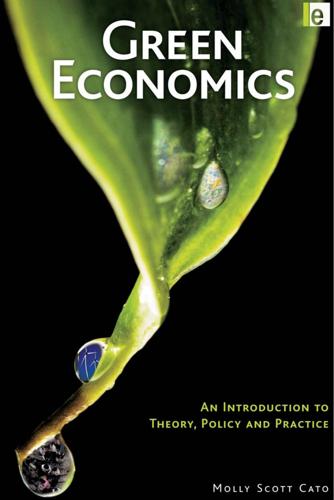
Green Economics: An Introduction to Theory, Policy and Practice
by
Molly Scott Cato
Published 16 Dec 2008
S. 80 capital 96 see also Five Capitals Framework capitalism 11, 59, 90–92 carbon cycle 98–99 carbon dioxide emissions 98, 110–113, 130, 164, 165 carbon permits 111–112 carbon tax 164 carbon trading 110 Chiemgauer 82 China 128, 141 Chipko movement 189 Christianity 21 Citizens’ Income 181–182 climate change 1, 12, 98, 109–113, 129–130 closed system 48 CLT (Community Land Trust) 195, 196 Club of Rome 39 CO2 emissions 98, 110–113, 130, 164, 165 co-housing 196–197 commodity prices 126 commons, taxation 162–164 community business 68 Community Land Trust (CLT) 195, 196 community-supported agriculture (CSA) 95, 200–202 comparative advantage 124–126 competition 127–128 complementary currencies see local currencies Conable, B. 123 Conaty, P. 195 congestion charge 163 construction sector 107–109 220 GREEN ECONOMICS consumers 63 consumption 10, 96, 174 Contraction and Convergence 111 convivial economy 42, 44, 101 cooperatives 63, 64–65, 94, 95 co-production 80 core economy 80 corporate social responsibility (CSR) 92–93 cowboy perspective 11, 25 CSA (community-supported agriculture) 95, 200–202 CSR (corporate social responsibility) 92–93 Cuba 153, 201 Curtis, F. 145 Daly, H. 9, 25, 40, 115 Dawson, J. 194 debt-based money system 72, 73, 78 democratization, money system 74 demurrage 82 Denmark 167, 197 deskilling 61–64 Diggers 189 direct action 133 disembedding 183, 187 domestic work 114 Douthwaite, R. 27–29, 206 cooperatives 64–65 economic growth 9 economics 43 green growth 40 local self-reliance 145, 153–154 money 77 drug manufacturers 184 dumping, economic 135 early human societies 176 ecofeminism 35, 46 ecological economics 7, 40 ecological footprint 8 ecological modernization 106–109 ecological rucksack 96 ecological virtue 18 ecology 4, 190 economic growth 9–10, 38–39, 83, 174 economic indicators 116–120 see also GDP economics 11, 30–31, 41–45 economic security 120 ecotaxes 164–168 ecovillages 194 ecowelfarism 180 Emissions Trading Scheme (ETS) 110 see also carbon trading employment 58 empowerment 63 enduring terrors 178–179 energy 26, 92, 95–96 energy return on energy invested (EROI) 100 energy tax credits 166 entropy law 26 environmental catastrophes 114–115 environmental crisis 105, 178 environmental economics 6, 7 environmental justice movement 178 environmental movement 39 environmental taxes see ecotaxes equity 159, 160, 172 EROI (energy return on energy invested) 100 ETS (Emissions Trading Scheme) 110 European Union (EU) 109, 110, 143, 166 externalities 6 fair trade products 95, 128–129 farmers’ markets 95 farming 197–202 financial system, international 74–77 Five Capitals Framework 96 Fleming, D. 44, 112 food 62, 95, 140, 147 food miles 62 food security 143 formal economy 5 France 143 free trade 123, 126–129 Freire, P. 29 Funtowicz, S.
…
Self-reliant local economies on the ground For many greens, waiting for government policies to support local economies is not an option: they believe that we need secure access to our basic resources and are working to develop local systems of production and distribution. Fred Curtis describes such a system of interrelated but independent local economies as ‘eco-localism’ and argues that it includes: ‘local currency systems, food coops, micro-enterprise, farmers’ markets, permaculture, community-supported agriculture (CSA) farms, car sharing schemes, barter systems, co-housing and eco-villages, mutual aid, home-based production, community corporations and banks, and localist business alliances’.15 According to Richard Douthwaite,16 the four basic steps towards greater local self-reliance are: • setting up an independent currency system so that the economy can still function no matter what happens in the global financial system; 146 GREEN ECONOMICS Figure 9.3 NEF’s image of the ‘leaky bucket’ local economy Source: Thanks to nef (the New Economics Foundation) for permission to reproduce this figure
…
Having been amended it gained the support of a majority of Scotland’s elected members and now provides support for organic farmers as a sustainable sector. The target for the plan was to have 30 per cent of Scotland’s arable or grassland in organic production by 2007. Linking concerns with ownership and with sharing and reconnecting with the land brings us to a system of farming known as community-supported agriculture (CSA). As in the example of Stroud Community Agriculture (Box 12.5), such schemes change the relationship between farmer and consumer, who now enjoy a much closer link than that typical in the market. Participants in a CSA pay an annual or monthly amount to support the farmer in her/his vital role and then receive a share of the produce.
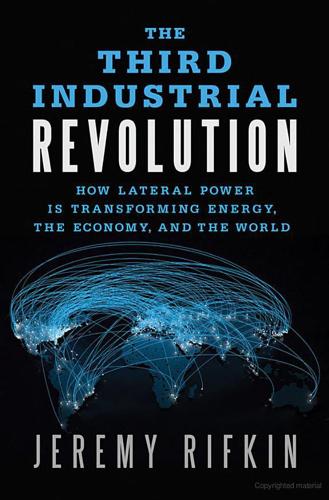
The Third Industrial Revolution: How Lateral Power Is Transforming Energy, the Economy, and the World
by
Jeremy Rifkin
Published 27 Sep 2011
New collaborative business practices are reaching into every aspect of economic life. Community Supported Agriculture (CSA) is a good example of the impact that new TIR business models are having on how food is grown and distributed. After a century of petrochemical-based agriculture, which led to the near demise of the family farm and gave birth to giant agrifarm businesses like Cargill and ADM, a new generation of farmers is turning the tables by connecting directly with households to sell their produce. Community supported agriculture began in Europe and Japan in the 1960s and spread to America in the mid-1980s.
…
The share usually consists of a box of fruits and vegetables delivered to their door (or to a designated drop-off site) as soon as they ripen, providing a stream of fresh, local produce throughout the growing season. The farms, for the most part, engage in ecological agriculture practices and utilize natural and organic farming methods. Because community supported agriculture is a joint venture based on shared risks between farmers and consumers, the latter benefit from a robust harvest and suffer the consequences of a bad one. If inclement weather or other misfortunes befall the farmer, the shareholders absorb the loss with diminished weekly deliveries of certain foods.
…
If inclement weather or other misfortunes befall the farmer, the shareholders absorb the loss with diminished weekly deliveries of certain foods. This kind of peer-to-peer sharing of risks and rewards binds all of the shareholders in a common enterprise. The Internet has been instrumental in connecting farmers and consumers in a distributed and collaborative approach to organizing the food supply chain. In just a few years, community supported agriculture has grown from a handful of pilots to nearly three thousand enterprises serving tens of thousands of families.29 The CSA business model particularly appeals to a younger generation that is used to the idea of collaborating on digital social spaces. Its growing popularity is also a reflection of the increasing consumer awareness and concern about the need to reduce their ecological footprint.

What's Mine Is Yours: How Collaborative Consumption Is Changing the Way We Live
by
Rachel Botsman
and
Roo Rogers
Published 2 Jan 2010
On a trip to Paris, we saw cyclists pedaling around on sleek-looking bikes with the word “Vélib’” (Paris’s bike-sharing scheme) on their crossbars. A friend in London told us about her new favorite Channel 4 TV program called Landshare. And we kept hearing about the number of people joining Community Supported Agriculture (CSA) programs or local co-ops. We saw stats and stories about online cooperation and the growth in virtual communities. Every day there are more than 3 million Flickr images loaded; 700,000 new members joining Facebook; 5 million “Tweets”; and 900,000 blogs posted. There are twenty hours of YouTube videos loaded every minute, the equivalent of Hollywood releasing more than 90,000 new full-length movies into theaters each week.1 “Collaboration” had become the buzzword of the day with economists, philosophers, business analysts, trend spotters, marketers, and entrepreneurs—and appropriately so.
…
The company satisfies a range of needs, from one-month packages such as the Cherry, aimed at grandparents, where you pay a onetime fee of 49.95 euros for five toys, to longer-term monthly subscription rates for parents, such as the Maxi, where you pay 25 euros for six toys every month. Different ways of receiving a service are another way to think of diversified access. Consider food networks between farmers and urban dwellers. Some urbanites may choose to get their local food from farmers’ markets or get it delivered via a community-supported agriculture scheme; others may choose to join a land-share or yard-share program; still others might work at a co-op in exchange for discounted prices. Either way, a system of local food production is enhanced. Diversified access creates different degrees of participation for consumers, as with toy rentals, or different kinds of participation, as with local food systems.
…
What will become the American Express of social currencies? In the space of a little more than a decade, we have seen the evolution of traditional banks to social lending marketplaces to completely new forms of peer-to-peer virtual currencies such as VEN. In the food sector, retail food cooperatives have surged in popularity, community-supported agriculture programs have more than tripled, and now through SharedEarth and Landshare, we are seeing people share their own gardens. Even in a specific sector such as car sharing, there has been rapid progress in how we are cooperating. Companies such as Zipcar and Streetcar, where there is a trusted intermediary to orchestrate the sharing of cars we don’t own, have been thriving.
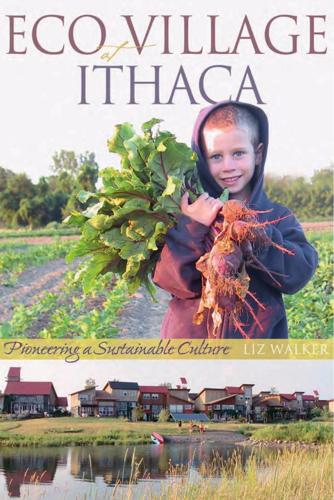
EcoVillage at Ithaca Pioneering a Sustainable Culture (2005)
by
Liz Walker
Published 20 May 2005
Each subcommittee worked hard to figure out solutions appropriate to the EcoVillage site. For example, the agriculture committee held a forum on agricultural models. They wanted to know if the community would rather participate in a commonly owned farm similar to an Israeli kibbutz or develop a privately owned farm supported by members (community-supported agriculture, or CSA). In another project, the natural areas committee undertook a plant species survey with Chuck Mohler from Cornell. I remember sitting in the middle of a field and counting the number of goldenrod plants in a square yard. Our discussions and decisions as a group during this time seemed charged with electrical energy, and we felt the sheer creative power of invention.
…
Established by Jen and John Bokaer-Smith, the 10acre (4-hectare) farm is certified organic by the Northeast Organic Farming Association (NOFA). Unlike other farms, it will never feel the pressure of developers eager to create another subdivision, since it is protected by EVI’s permanent conservation easement. The farm is also a Community Supported Agriculture (CSA) farm. A CSA farm creates a web of connection between people and the land. By joining a CSA, people can enjoy organic seasonal food produced close to home at the same time as they help sustainable agriculture to 39 40 E C O V I L L A G E AT I T H A C A flourish. Shareholders pay a portion of the farm’s expenses and in return receive a weekly bounty of freshly picked vegetables, herbs, and flowers all through the growing season (from late May to early November).
…
CLT: Community Land Trust is an organization that supports land preservation, affordable housing, and organic farming. CRESP: Refers to the Center for Religion, Ethics, and Social Policy, a nonprofit organization affiliated with Cornell University that assists projects working to promote peace, justice, and sustainable communities. EVI started as a project of CRESP. CSA: Community Supported Agriculture, a farm in which consumers buy advance shares in the harvest and share the risks and benefits of the farm’s operation. West Haven Farm is an organic CSA farm. ETC: Refers to the nonprofit organization Educate the Children, founded by Pamela Carson to raise money in the US to support impoverished children in Nepal.

ECOVILLAGE: 1001 ways to heal the planet
by
Ecovillage 1001 Ways to Heal the Planet-Triarchy Press Ltd (2015)
Published 30 Jun 2015
Nine months later we finished the neighborhood and everyone moved in. Today we have 3 neighborhoods, and each has its own story. In 2015, with 100 homes our neighborhood development is complete. In Co-housing neighorhoods, children always find friends to play with. Community-Supported Agriculture We have 3 organic farms on site, a very important part of our overall vision and mission. We use CSA (Community-Supported Agriculture) in which consumers pay the farmers at the beginning of the growing season, then get a weekly share of the harvest. Our first farm, West Haven Farm, has 11 acres and feeds 1,000 people during the season. Our second farm is 5 acres and is also run by a resident.
…
We tried to take it to the local market to sell. But the price was so low it wasn’t worth it. We then decided to give the broccoli away as gifts, having such abundance. However, this wasn’t a good role-model for local farmers, given that agriculture is their income. In 2006, we started a Community Supported Agriculture (CSA) scheme in Ankara. In the first year more than ninety people joined. We collected money to employ a farmer from the village and introduced him to new techniques: raised beds and drip irrigation. The villagers were still using the traditional irrigation method of flooding the fields, which uses a lot of water.

It Doesn't Have to Be Crazy at Work
by
Jason Fried
and
David Heinemeier Hansson
Published 1 Oct 2018
None of these things have anything to do with work at Basecamp—they all have to do with encouraging people to do things they’ve always wanted to do but needed a bit of encouragement and help to actually make happen. $2,000 per year charity match. Donate to a charity of your choice up to $2,000, and we’ll match it up to $2,000. A local monthly CSA (community-supported agriculture) share. This means fresh fruits and vegetables at home for people and their families. One monthly massage at an actual spa, not the office. $100 monthly fitness allowance. We’ll basically pay for people’s health club membership, yoga classes, running shoes, race registrations, or whatever else they do to stay healthy on a regular basis.
…
The idea isn’t to cram more stuff into fewer hours, so we adapt our ambition, too. Winter is when we buckle down and take on larger, more challenging projects. Summer, with its shorter 4-day weeks, is when we tackle simpler, lighter projects. We also celebrate the seasons outside of work at Basecamp by covering the cost of a weekly community-supported agriculture share for each employee. Fresh, local, seasonal fruits and veggies in people’s homes. This is a year-round benefit, but the bounty naturally changes with the seasons. It’s a delicious, healthy way to celebrate change. Be it in hours, degrees of difficulty, or even specific benefits that emphasize seasonality, find ways to melt the monotony of work.
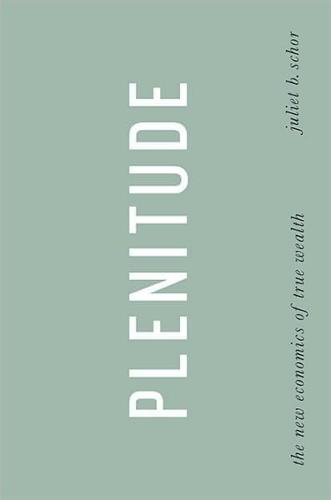
Plenitude: The New Economics of True Wealth
by
Juliet B. Schor
Published 12 May 2010
Its ability to get us through prolonged economic and ecological distress is questionable, in part because the economic relations that keep people together are less developed. Sustainability activists are keenly aware of the decline of social connection and are attempting to rebuild it by creating a face-to-face economy. The local-food movement is the best known of these efforts. In urban areas, groups are organizing farmers’ markets, CSAs (community-supported agriculture programs), and community gardens. The Business Alliance for Local Living Economies, a national network with more than seventy-five local chapters, supports local entrepreneurs and promotes the viability of renewed regional and local economies. Efforts to create local currencies are growing.
…
Individuals are planting vegetable plots, community gardens are sprouting, and in a number of major cities, efforts to grow healthy organic food for inner-city residents are thriving. Detroit, Milwaukee, and Chicago all have large-scale organizations that are reshaping residents’ food habits. Farmers’ markets, community-supported agriculture, local sourcing by restaurants, Slow Food chapters, school-yard gardens, and related initiatives are on the rise. Practices are expanding from simple vegetable plots to urban homesteading. People are growing mushrooms, keeping bees, and raising livestock. A chicken underground has sprung up in cities with laws against backyard poultry, and urban poultry households stretch from Los Angeles to South Portland, Maine.
…
Cleveland, Ohio climate change Congress and cost benefit in limiting of deaths and other costs of economic activity and eco-optimism and extinctions and fossil fuels and planetary boundaries and poverty and income inequality and rate of technology and limiting of - see also environment clothing currency function of disposal of environmental impact of fashion cycle and prices of reuse of self-provisioning and Club of Rome coal rebound effect in use of cohousing communities Columbia University community-supported agriculture programs (CSAs) composting computers materials flow and open-source movement and prices of storage and disposal of Congress, U.S.: BEA environmental studies and climate change and consumption, consumerism carbon and product scores and clothing and, see clothing end of life (EOL) and environmental impact of expansion of fashion and material flows and population and storage and disposal issues in symbolic value and well-being and Container Store cooperatives copyrights coral reefs Costa Rica cost-benefit analysis cotton Craigslist Creative Commons creative destruction credit credit unions currency Daily, Gretchen Daly, Herman dams Dasgupta, Partha debt deforestation de Graaf, John Denmark, ecological footprint in Depression, Great desertification DICE (Dynamic Integrated Climate-Economy) digital fabricators discount rate-5n diseases droughts Dudley Street Neighborhood Initiative durable goods: department store index for prices of weight of dynamic efficiency Earth Institute Earth Restoration Corps Easterlin, Richard eBay ecocide eco-efficiency ecological commons ecological footprint hours worked and ecological modernization ecological optimism economy: aggregate growth and business-as-usual form of, see business-as-usual (BAU) economy climate change and community and energy efficiency and extra-market diversification and financialization and flexible production and human behavior and information exchange and Keynes and materials use and extraction and need for alternative form of physical capital and rebound effect and scale of production and efficiency of self-provisioning and service sector of shifting the conversation on time wealth and “too big to fail” dilemma and U.S., historical profitability of value as measure in world, growth of see also environmental economics ecovillages education efficiency Egypt Ehrlich, Paul electric industry electric vehicles electronics, consumer imports of material flow and multifunctionality and storage and disposal of see also specific products Elpel, Renee Elpel, Tom Empire of Fashion (Lipovetsky) employee-owned companies employment, see labor; unemployment end of life (EOL) energy: housing and price of rebound effect from efficient use of systems dynamics and taxes and use of see also specific energy sources energy economics environment ecological footprint in, see ecological footprint ecological optimism and economic activity and feedback loops and full-cost pricing and integrated assessment models and mainstream economics and planetary boundaries and restoration of UN assessment of (2005) water footprint and see also climate change environmental economics cost-benefit analysis and customization and household production and production possibilities curve and reciprocity and resale and reuse and sharing and trade-off view of -4n working less and see also economy Environmental Kuznets Curve (EKC) -3n Europe: cohousing in ecological footprint in health care in historical carbon emissions of materials consumption in passive solar building in population decline in product life extension policies in European Society for Ecological Economics EV1 electric car extensive growth extinctions extra-market diversification ExxonMobil fabrication laboratories (fab labs) cost of Factor e Farm Farm, The (Tenn.)
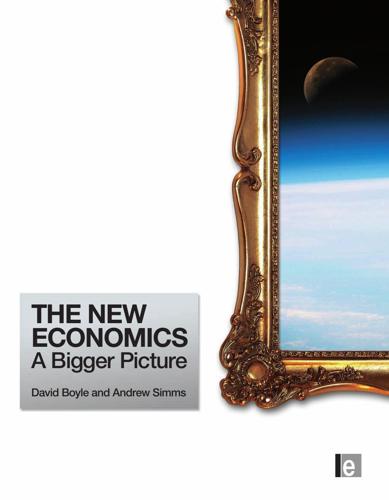
The New Economics: A Bigger Picture
by
David Boyle
and
Andrew Simms
Published 14 Jun 2009
Seikatsu allowed people to band together and buy healthier, local food wholesale, and in the end produce their own. It also soon became clear that there was a sizeable and growing minority of people who are involved in the emerging new economics paradigm in their everyday lives, and a sector is emerging to support them, providing green energy, ethical investment, community-supported agriculture and organic food. There was some evidence that this was the growing portion of the UK population known to marketers as ‘inner-directed’, or ‘cultural creatives’ in the USA, who sympathized with this even if they were not involved in buying organic themselves. They seem to make up around 40 per cent of the UK population and maybe a quarter of Americans.17 A BRIEF HISTORY OF THE NEW ECONOMICS 27 But as the new economics developed, the background was also shifting.
…
Food is an absolutely critical component in the new economics, not supported by central grants but by providing effective local markets that are not undercut by subsidized products dumped from the other side of the world. The rise of farmers’ markets is one sign that they may survive after all. So is community-supported agriculture, a Japanese idea that has been taken up in the USA and the UK, whereby people support a local farm with a subscription and receive a guaranteed box of vegetables at their door every week. Take the corporate ownership and control out of the food chain Over 90 per cent of consumers rejected GM food in the last poll in the UK, and many farmers in developing countries are suffering from the heavy cost and poor-to-average yields of GM seeds.
…
(Gilbert Keith) 18, 20, 21, 81 Chicago (Illinois) 87, 127, 131 chief executives 19, 141, 142 children 4, 46–7, 82, 86, 87 Chile 51 China 28, 50, 60, 82, 100, 116, 154 CHP (combined heat and power) plants 102, 103 cities 3, 61, 75, 80, 105–6, 110, 116 and energy 102, 103 traffic speeds 65–6 citizen’s incomes 45, 58, 73, 91–2, 148 Clarke, Otto 21 classical economics 28–9, 34–5, 44, 67, 89, 123 assumptions 71, 72, 85 Cleveland (Ohio) 6 climate change 3–4, 40, 96, 112, 115 tackling 45, 90, 155, 157 Clinton, Bill 27, 52, 145 co-generation of energy 102, 103 co-production 88–9, 127–31, 132, 158, 159 Cobb, Clifford 39, 40–1 Cobb, John 22, 40–1 collateralized debt obligations (CDOs) 5–6 Colombia 33, 51 Columbus, Christopher 139 combined heat and power see CHP commodities 11, 57, 139 currencies based on 60, 90, 120 commons 79, 82, 113, 148 communications technologies 58, 59, 78, 158 communities 2, 27, 42, 43, 89, 92 assets 57–8, 106 investing in 118 money in 103–5, 107, 124, 151–2 Wal-mart and 124–5 community 32, 33, 54, 89, 158 community banks 26, 145 community land trusts 46, 73, 151 Community Way model 58 community-supported agriculture 26, 119 companies 74–5, 84, 137–8, 142–3 see also corporations comparative advantage 26, 75, 109, 116 competition 90 regulation 85, 113, 125, 126, 133 complementary currencies 26, 57–8, 59, 62, 154 consumerism 20, 44, 132 consumers 44, 67–8 consumption 11, 34, 39–40, 100, 158 ‘defensive’ 37 contributing, need for 128–9 conventional economics 10–12, 82, 97, 127 cooperatives 20, 26, 153 ‘core economy’ 54–5, 88, 89, 127, 158 corporate debt 84, 142–3 corporate power 20, 28, 85 corporate raiders 84, 142 corporate responsibility 26, 153–4 corporations 4, 8, 13, 82, 90, 116, 142, 158 tax gap 52, 137, 157 Costa Rica 99 Country Party 18 crashes 1, 51, 91 2008–9 crash 2, 3, 5, 6–7, 8, 15, 84, 85, 154–5 creativity 38, 46, 75, 79, 91 credit 91, 145–6 see also debt credit cards 84 credit crunch 3, 91, 144, 157 credit unions 26, 144, 145, 146 crime 10, 35, 37, 38, 87, 127, 128 crises, fundamental 3–5 Cuba 95–7, 101, 105 culture 43, 44, 111, 115, 127, 158 INDEX 183 currencies 26, 55, 56–8, 81 barter currencies 58, 59 based on commodities 60, 90, 120 based on emissions rights 90, 148 big 53, 54, 55–6, 58, 59 complementary 26, 57–8, 59, 62, 154 global 56, 61, 120, 147–8 local 26, 27, 56, 57, 58, 60, 151–2, 153 multiple 58, 59–60, 60, 90 regional 58, 59, 60 domestic tradeable quotas (DTQs) 117–18 Douthwaite, Richard 56–7, 148 Downs-Thomson Paradox 66 downshifting 2, 4–5, 11, 35, 69, 73 Drexel Burnham Lambert 142 drugs, generic 113, 116, 117 DTQs (domestic tradeable quotas) 117–18 Dublin (Ireland) 52, 106 DuPont 85 dynamic equilibrium 43, 44 Daly, Herman 22, 23, 40–1, 43, 97 Dawnay, Emma 71 debt 4, 7, 11–12, 81, 83–4 cancellation 137, 148 corporate 84, 142–3 and development 138–43 GM crops and 91, 119, 140 Malawi 135–6 medieval freedom from 79, 80–1 money creation 7, 8, 11, 56, 60, 84, 90, 138 national 49–50, 83, 84, 139, 141 personal 7, 36, 83–4, 91, 140, 141 repayments 90, 137 small-scale 143–4 see also sub-prime loans decentralized energy generation 102–3, 106, 114, 155 decision making 67–8, 71, 158 ‘defensive consumption’ 37 democracy 31, 55, 91, 141, 158 demurrage 57 depression 4, 10, 11, 35, 38, 68, 75, 83 deregulation 8, 12, 22, 28 developing countries 11, 81, 136–8, 143 development 24, 27, 116, 138–43 development projects 82 Dickens, Charles 36 Diggers 18 Disney 141 Distributism 19–21, 29 District of Columbia School of Law 131 diversity 82, 90, 152 Earth, Apollo pictures of 101–2 EBCU (emissions-backed currency unit) 148 ecological debt 113–14 ecological footprints 31, 33, 34, 112 ecological issues 3–4, 12, 25 economic activity 25, 148 economic development 24, 27, 116, 138–43 economic growth see growth economic indicators, alternative 26 economic institutions 29, 82, 153, 154 economic processes 97–8, 99 economic system 2, 11, 21–2, 23, 29, 112, 138 and poverty 13–14, 18, 29, 81–2, 154 economics 10–12, 18, 19, 29, 72–3, 98 assumptions 10, 25, 28, 29, 69, 71, 72, 82, 85, 97, 99, 115 medieval 78–80, 80–1 post-autistic 9–10, 71–2 and psychology 67–8, 71, 72–3 as a science 15, 34–5, 98, 152 and sustainability 24 see also classical economics; conventional economics; new economics economy 12, 26, 84–5, 158 creating poverty 13–14, 18, 29, 81, 154 ecosystems 99, 112, 114 Edison, Thomas 58, 90, 147 education 13, 33, 35, 46, 113 efficiency 4, 13, 99, 100, 123, 126, 131–2 E.F.

Beautiful Solutions: A Toolbox for Liberation
by
Elandria Williams, Eli Feghali, Rachel Plattus
and
Nathan Schneider
Published 15 Dec 2024
Climate change and the destruction of our ecosystems, like clearcutting forests. WHAT ARE SOME OF THE MOST PROMISING STRATEGIES? Seed sharing and seed libraries. Permaculture. Agroecology. Regenerative ocean and land farming. Food sovereignty. Regional food system planning. Small farmer cooperatives. Consumer cooperatives and buying clubs. Community-supported agriculture. HOW ARE WE MAKING BEAUTIFUL TROUBLE? Reappropriation of underutilized land. Civil disobedience. Defying property law for our right to grow food, access seeds, and repair technology. HOW CAN WE HEAL? Restoring traditional and Indigenous agriculture practices and relationships to the land.
…
WRITTEN BY EMI DO Do is owner-farmeroperator of a small urban farm in Vancouver, Canada, and co-founder of FarmCity Co-op, a producer cooperative of urban farmers. She holds a PhD in agricultural economics from Tokyo University of Agriculture, where she studied large-scale cooperatives in Japan. There are many examples of initiatives that show us what food sovereignty looks like. Community-supported agriculture (CSA) programs, for instance, are based on a mutual commitment between producers and consumers to share the risks and rewards of agriculture. The CSA concept exists around the world under many different names and arrangements, shaped by the unique needs of the local farmers and consumers.
…
” — FROM THE DECLARATION OF NYÉLÉNI In the face of frequent temptations to compromise with the status quo, the principles of food sovereignty provide an essential North Star for the farmers producing our food, the communities striving to nourish their families, and everyone in between. LEARN MORE REPORT “Nyéléni 2007: Forum for Food Sovereignty” by the Nyéléni 2007 International Steering Committee. (2007) nyeleni.org/DOWNLOADS/Nyelni_EN.pdf GUIDE “Sharing the Harvest: A Citizen’s Guide to Community Supported Agriculture” by Elizabeth Henderson and Robyn Van En. (2007) viacampesina.org/en/international-peasants-voice WEBSITE English-language materials and video about La Via Campesina and the international peasant movement by La Via Campesina. (2021) mitpressbookstore.mit.edu/book/9781933392103 SOLUTION PARTICIPATORY GUARANTEE SYSTEMS Meeting of an organic producer group in rural Moneragala in southeastern Sri Lanka.
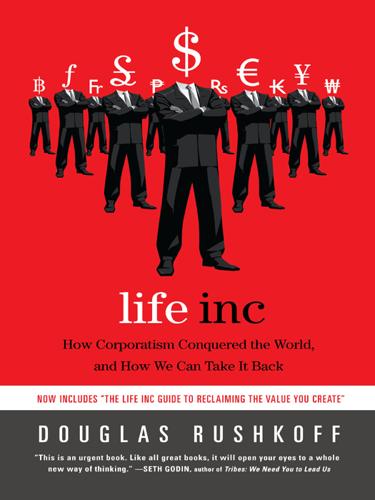
Life Inc.: How the World Became a Corporation and How to Take It Back
by
Douglas Rushkoff
Published 1 Jun 2009
Only eighteen cents of every dollar, when buying at a large supermarket, go to the grower. Eighty-two cents go to various unnecessary middlemen. Cut them out of the picture and buy your food directly from your local farmer. Community Supported Agriculture Thinking about signing up for a CSA but want to learn more about the idea before you commit? Read on. Over the last twenty years, community supported agriculture (CSA) has become a popular way for consumers to buy local, seasonal food directly from a farmer. Here are the basics: A farmer offers a certain number of “shares” to the public. Typically the share consists of a box of vegetables, but other farm products may be included.
…
Pushing toxic waste out of one neighborhood forces the dumping corporations to find a new place for it; prices on processing garbage go up, and corporations are encouraged to make less trash in order to preserve their bottom line. While rooftop agriculture may not feed our entire metropolitan population, plenty of other opportunities exist for those seeking a more direct connection with the people and places making their food. Community-supported-agriculture groups, or CSAs, let typical food consumers become members of their local agricultural community. Instead of buying Big Agra produce shipped long distances to the supermarket, people make a commitment to buy a season’s worth of crops from a local farm and then either pay up front or by subscription over the course of a year.
…
Corporations can come through with technology and infrastructure that support local business, while thriving local commerce provides an alternative source of employment and stability when corporations fail, as they did in Lansing. Some readers, in less dire straits but just as committed to taking back the world from corporatism, felt daunted by how few specific suggestions I made for taking back the world. Joining a CSA (community supported agriculture) group sounds, well, just too easy to fix any big problem, and too inconvenient to bother with. Or a babysitting club? Like that’s going to take back the world? I believe it can. And more important, you can. In the opening chapter of the book, we looked at how each compromise we make to corporatism leads to further compromises.
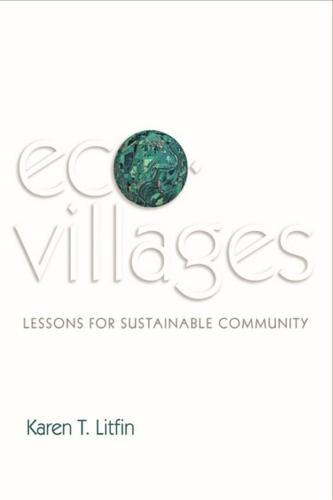
Ecovillages: Lessons for Sustainable Community
by
Karen T. Litfin
Published 16 Dec 2013
What did surprise me were the points of divergence, the impact of certain ecovillages on the larger society’s relationship to food, and the creative possibilities that emerge when people start thinking outside the box. Located on the edge of a small city, EcoVillage at Ithaca illuminates these possibilities nicely. Community-supported agriculture For Joan Bokaer, the woman whose ideas gave birth to EVI, food was at the core from the beginning. A white-haired woman with angular features, Joan describes her vision in practical terms: “A livable city needs a symbiotic relationship with its source of food.” Joan believes that EVI’s primary work is to support urban agriculture.
…
Joan believes that EVI’s primary work is to support urban agriculture. Joan’s daughter, Jen, is helping to make that vision a reality. Jen returned to EVI from college with her future husband, John – both of them having a passion for organic farming and an interest in establishing a community-supported agriculture (CSA) system. The essence of the CSA model is both economic and social: to spread the financial risk of small-scale farming while strengthening the bonds between producers and consumers. Consumers purchase advance shares in the harvest, thereby sharing the risks and benefits of farming and removing the sense of anonymity that pervades the dominant agribusiness model.
…
The rest is sold at the local farmers’ market. All told, Jen and John supply high-quality produce to about a thousand people for six months of the year. Without EVI, it is doubtful that a flourishing farm would exist on this prime real estate at the city’s edge. West Haven Farm gives new meaning to community-supported agriculture: it exists within the community that supports it. Unlike most CSA farmers, Jen and John live side by side with their most committed members. This proximity, both geographic and emotional, bodes well for the farm’s future. But in a world where organic food is mass-produced by industrial farms, the success of West Haven Farm is far from assured.
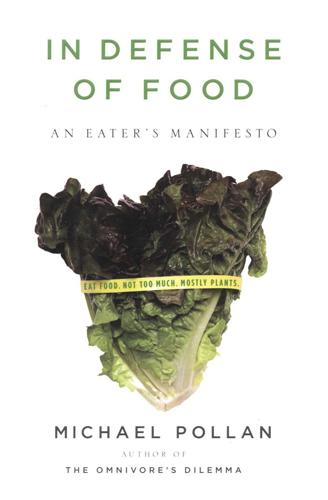
In defense of food: an eater's manifesto
by
Michael Pollan
Published 15 Dec 2008
What you will find are fresh whole foods picked at the peak of their taste and nutritional quality—precisely the kind your great grandmother, or even your Neolithic ancestors, would easily have recognized as food. Indeed, the surest way to escape the Western diet is simply to depart the realms it rules: the supermarket, the convenience store, and the fast-food outlet. It is hard to eat badly from the farmers’ market, from a CSA box ( community-supported agriculture, an increasingly popular scheme in which you subscribe to a farm and receive a weekly box of produce), or from your garden. The number of farmers’ markets has more than doubled in the last ten years, to more than four thousand, making it one of the fastest-growing segments of the food marketplace.
…
refined refined vs. fiber cardiovascular disease carotenes beta- carotenoids carrots cars, eating in case-control studies cell membranes cell metabolism cereals health claims for chewing chicken “free range,” Child, Julia children see also baby formula Children’s Hospital and Research Center China food from China Study, The (Campbell) chocolate, milk ”chocolate cake,” response to cholesterol, blood good vs. bad lowering of cholesterol, dietary heart disease and oxidized vs. ordinary CIA World Factbook, Claiborne, Craig Clinton, Bill Coca-Cola coca leaves coffee cohort studies colon colon cancer colorectal cancer common sense community-supported agriculture (CSA) confounders confusion Congress, U.S. see also Senate, U.S. Conspiracy of Scientific Complexity convenience food cooking corn with beans dominance of corn flour corn oil corn syrup avoiding products with cows feeding of C-reactive protein Crete culture eating and Western diet and see also manners, mores, and habits dairy products omega-3s vs. omega-6s in rationing of see also butter; milk D.A.S.H.
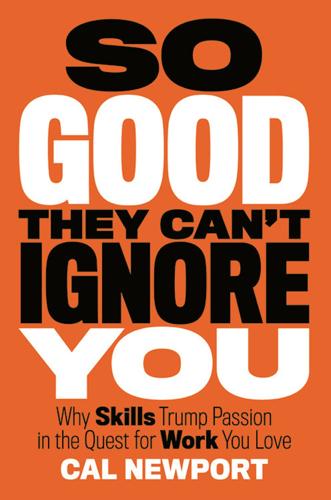
So Good They Can't Ignore You: Why Skills Trump Passion in the Quest for Work You Love
by
Cal Newport
Published 17 Sep 2012
The land quality in Granby is mixed—it’s too far east from the Connecticut River to guarantee access to the river valley’s best soil—but Ryan still managed to coax a variety of fruits and vegetables out of his plot. He called the fledgling concern Red Fire Farm. When I arrived in May 2011 to spend a day at Red Fire, Ryan, who is now working with his wife, Sarah, had seventy acres of organic produce under cultivation. The bulk of Red Fire’s revenue comes from their Community Supported Agriculture (CSA) program, in which subscribers pay for a share of the farm’s output at the beginning of the growing season and then pick up their produce every week at distribution stands throughout the state. In 2011, the program had around 1,300 CSA subscribers and had started to turn people away—there was more demand than they could meet.
…
But once he got going on his farming strategies, explaining the difference between Merrimack sandy loam and Paxton silt loam, for example, or his new weeding strategy for the carrot beds, his shyness gave way to the enthusiasm of a craftsman who knows what he’s doing and has been given the privilege to put this knowledge to work. I noticed a similar enthusiasm in Sarah when she discussed her efforts to manage the farm’s CSA program and public image. When Sarah joined Ryan in Granby in 2007, she was already an advocate for both organic farming and community-supported agriculture. She had studied environmental policy at Vassar, where she’d stumbled on the college’s Poughkeepsie Farm Project CSA. Inspired, she started her own small-scale CSA program after graduating, in nearby Stafford Springs, Connecticut. Coming to Red Fire gave Sarah the opportunity to promote these beliefs on a larger scale—a challenge she clearly relishes.
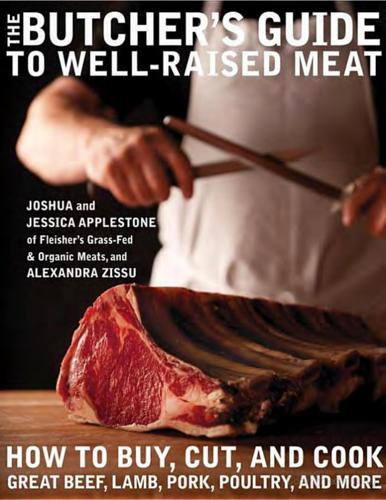
The Butcher's Guide to Well-Raised Meat: How to Buy, Cut, and Cook Great Beef, Lamb, Pork, Poultry, and More
by
Joshua Applestone
,
Jessica Applestone
and
Alexandra Zissu
Published 6 Jun 2011
We don’t ship, Tother because we prefer that people come to see what we’re about or support their own local industry and farmers. (Not to mention the fact that the carbon footprint of shipping is monumental, and meat doesn’t travel well.) Take the time to nd good, local farmers before you shop. Where you shop is as important as what you shop for. Farmers’ markets, Community Supported Agriculture (CSA) meat shares, farm stands, direct sale from farms, and natural food stores are far more likely to have good choices than most supermarkets. Some butcher shops stock pastured meat, but most carry the same boxed stuff supermarkets do. When choosing where to spend your money, it helps to know what you’re looking to buy.
…
See also Chicken recipes after slaughter breasts, skin-on boneless eggs from home fabrication pastured vs. organic vs. conventional popularity of primal cuts producer cooperative system safe handling of sizes and weights terms used for thighs, boneless skinless washing Chicken recipes Butterflying a Chicken Chicken Liver Pâté Fleisher’s “Secret” Chicken Rub Japanese Fried Chicken (Karaage) Chine bones Choice grade meat Cleaver Community Supported Agriculture (CSA) Cooking meat baking beef cuts braising broiling checking for doneness choosing best cooking method lamb cuts offal poaching pork cuts, 6.1, 6.2 roasting 335 sautéing searing stir-frying stovetop to oven method variety meats Cookware Corn, genetically modified Cornish game hen, defined Cow, defined Cutting boards Dairy products, buying Dark cutter, defined Defrosting meat Devon (red and black) breed Dogs, liver treats for Dough scraper Dressing percentage, defined Duck Duck fat E. coli, 2.1, 2.2, 2.3, 7.1 Ears, cooking Eggs, 9.1, 9.2 Ewe, defined Farm names Fat, rendering Fat, uses for, 3.1, 6.1 Fatback Feet, cooking Flanken Flank steak, names for Fleisher’s Grass-Fed & Organic Meats beef chicken 336 eggs history of lamb pork raw pet food standards for farmers, 1.1, 2.1 what they carry Food labels Animal Welfare Approved (AWA) Biodynamic Cage-Free Certified Humane Raised and Handled Free-Range/Free-Roaming Grass-Fed or 100 Percent Grass-Fed Local Natural, 9.1, 9.2 No Antibiotics Administered No Hormones Administered 100 Percent Vegetarian Feed Pastured/Pasture-Raised/Free-Farmed Sustainable USDA Certified Organic, 2.1, 9.1 USDA-verified Freezer orders Freezing meat, 4.1, 4.2 Frenching meat Fries (offal), cooking Genetically modified corn Gilt, defined Gizzards, cooking Gloucestershire Old Spot pedigree pigs Grades, USDA, 3.1, 7.1 Grandin, Temple Grass, for feed Grinder and hand stuffer 337 Grinder and hand stuffer Growth hormones, 2.1, 2.2, 9.1 Handsaw/bone saw Hand stuffer Hay, about Hearts, 3.1, 3.2 Heifer, defined Hen/stewing fowl, defined Hereford breed Highland breed Hog, defined Home fabrication beef chicken guidelines and tips knife skills for lamb pork Honing a knife Hook, metal Hook breaking Hormones, 2.1, 2.2, 9.1 Intestines, cooking Jaccard meat tenderizer Johnson, Ted Kidneys, 3.1, 3.2 Knives care for how to hold knife skills for meat-cutting sharpening 338 Lamb.
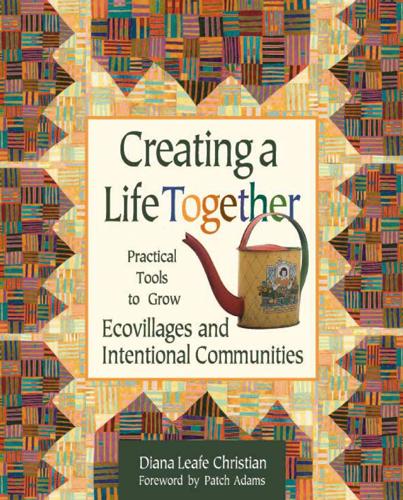
Creating a Life Together: Practical Tools to Grow Ecovillages and Intentional Communities
by
Diana Leafe Christian
Published 1 Jan 2003
Sirius Ecovillage near Amherst, Massachusetts, grows a large percentage of its organic food, generates a portion of its own offgrid power, and offers tours and classes on sustainable living. EcoVillage at Ithaca has built the first two of its three planned ecologically oriented cohousing communities on 176 acres near Ithaca, New York, and operates its own organic Community Supported Agriculture farm for members and neighbors. We’ll explore two aspiring ecovillages in the following chapters: Dancing Rabbit Ecovillage in Missouri, and Earthaven Ecovillage in North Carolina. I use the term “communities” in this to mean ecovillages as well as other forms of intentional community.
…
In fact, the more “progressive” the area, from Eugene to Boulder to Ann Arbor, the higher the population and the more likely local regulations made one-house/one-lot, stick-frame construction with flush toilets and a leach field the only kind of development possible. For a while the group contemplated settling in the same area as Ecovillage at Ithaca, in New York state, a project of three planned cohousing communities with energy-efficient, passive solar homes and an affiliated Community Supported Agriculture farm. One of the first built-fromscratch ecovillage projects in the country, Ecovillage at Ithaca was a tempting model, and it was near a progressive university town with possible jobs. But back in 1995, composting toilets and strawbale homes were out of the question in that location as well.
…
Offers information and assistance for creating community land trusts through consultation, books, and a revolving loan fund. Website < www.iceclt.org> E.F. Schumacher Society. Information, book publishing, workshops, and consulting on local economic self-reliance, through community land trusts,“shoe box banks,” microlending, local currencies, and community supported agriculture farms. Website <www.schumachersociety.org> Websites Author’s website. More resources for ecovillage and community founders: addditional information on zoning, communication skills, and other relevant topics; additional community success stories and cautionary tales; downloadable Sucessful Ecovillage Assessment Tool; updates on profiled communities; author’s workshop schedule.
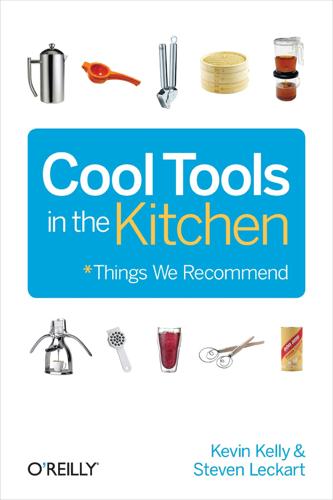
Cool Tools in the Kitchen
by
Kevin Kelly
and
Steven Leckart
Published 1 Dec 2011
Substitutes: salted buttermilk OR sour cream OR yogurt OR crema CSA Finder LocalHarvest LocalHarvest is a comprehensive one-stop resource for finding locally-grown food in the continental U.S. The site provides a customizable search feature on its homepage, and a simple zip code input provides you with a description and link to your closest Community Supported Agriculture option. Other search options include farmer’s markets, grocery co-ops, and restaurants that serve food made with organic ingredients. — Elon Schoenholz LocalHarvest Sample Excerpts Shared Risk There is an important concept woven into the CSA model that takes the arrangement beyond the usual commercial transaction.

Algorithms to Live By: The Computer Science of Human Decisions
by
Brian Christian
and
Tom Griffiths
Published 4 Apr 2016
More precisely, it is optimal assuming that you’re only interested in one metric in particular: reducing your maximum lateness. If that’s not your goal, however, then another strategy might be more applicable. For instance, consider the refrigerator. If you’re one of the many people who have a community-supported agriculture (CSA) subscription, then every week or two you’ve got a lot of fresh produce coming to your doorstep all at once. Each piece of produce is set to spoil on a different date—so eating them by Earliest Due Date, in order of their spoilage schedule, seems like a reasonable starting point.
…
(In a test, he got “Members of the Western Australian Legislative Council, 1962–1965” after just two reloads, and he grew up in Western Australia.) Knowing that these are actually randomly generated makes it possible to become better calibrated for evaluating other “coincidences” in the rest of his life. In the physical world, you can randomize your vegetables by joining a Community-Supported Agriculture farm, which will deliver a box of produce to you every week. As we saw earlier, a CSA subscription does potentially pose a scheduling problem, but being sent fruits and vegetables you wouldn’t normally buy is a great way to get knocked out of a local maximum in your recipe rotation. Likewise, book-, wine-, and chocolate-of-the-month clubs are a way to get exposed to intellectual, oenophilic, and gustatory possibilities that you might never have encountered otherwise.
…
See also uncertainty charity Cheshire, Stuart chess childhood Chomsky, Noam Churchill, Winston circuit switching clairvoyance clinical trials closet, organizing Cobham, Alan Cobham-Edmonds thesis Cockcroft, George (Luke Rhinehart) coconut water cognitive decline coincidences coins denominations two-headed tosses collators commitment problem communications. See also language; networking; storytelling confirmation priors and community-supported agriculture (CSA) Comparison Counting Sort comparison-shopping websites complexity penalizing computation, defined by Turing computational kindness confidence interval confirmation congestion avoidance of price of anarchy and Connection Machine constant-time (O(1)) constrained optimization problems constrained problem, preferences for Constraint Relaxation construction projects content distribution networks (CDNs) context switching continuous optimization problems Continuous Relaxation control without hierarchy Cooper, Martin cooperation Copernican Principle Copernicus, Nicolaus corporate marketing cost-benefit analysis Cramer, Jim Cravath system creativity crêpe stand queue Cross-Validation cryptography customer service hold times Darwin, Charles data.
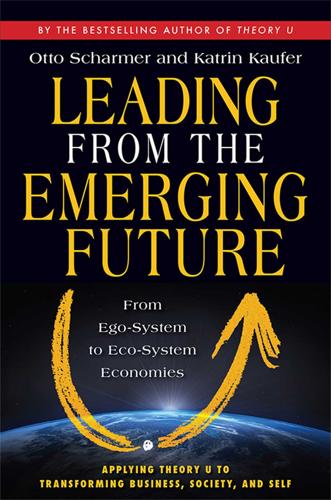
Leading From the Emerging Future: From Ego-System to Eco-System Economies
by
Otto Scharmer
and
Katrin Kaufer
Published 14 Apr 2013
The approach of William McDonough and Michael Braungart around rethinking the economic process as an earth-to-earth closed loop that integrates economics, eco-system science, chemistry, design, and systems thinking is another pioneering example for this line of work.14 The practical challenge in implementing these approaches lies in bringing together interests and players from the entire business ecosystem in order to make them see, think, talk, and work together—a challenge that we will inquire into more later, when we talk about the issue of leadership. SEEING OUR FUTURE: CULTIVATING OUR COMMONS There is a whole landscape of emerging examples that embody these principles: the Slow Food movement; community-supported agriculture (CSA); local food; local living economies; and sustainable sourcing practices.15 Biodynamic (organic) farming is one of these examples and close to our hearts because Otto grew up on a biodynamic farm in Germany.16 A biodynamic farm is based on the principles of zero importing (a closed-loop cycle), zero waste (every output of one sector is an input for another), diversity (crop rotation and diverse eco-systems instead of monoculture), and a symbiotic relationship among all these elements of the larger living system (the idea that each farm has a unique living individuality).
…
When the Fair Trade Movement began to eliminate the intermediaries between coffee producers in South America and coffee consumers in Europe, fair trade activists started to consciously redesign an economic system based on principles of transparency, inclusiveness, and fairness. Today examples of a 4.0 consumer movement are emerging everywhere: farmers’ markets, slow or local organic food, community-supported agriculture (CSA), organic-fabric clothing, eco-tourism, urban agriculture, car sharing, zero-emission cars, and renewable energy. Instead of just boycotting a product, the 4.0 consumer makes informed and intentional choices to support and co-create economic processes that are more inclusive, sustainable, transparent, and collaborative.
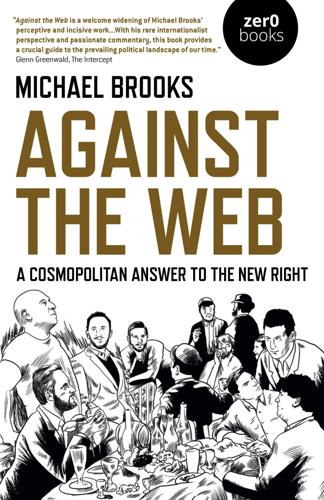
Against the Web: A Cosmopolitan Answer to the New Right
by
Michael Brooks
Published 23 Apr 2020
One of the latter’s many victories was to elect Chokwe Lumumba and then, after his untimely death in 2014, his son Chokwe Antar Lumumba, mayor of Jackson. In the words of Malaika Jabali, who discussed Cooperation Jackson with me on TMBS, Chokwe Antar Lumumba is “the most progressive mayor in America.” Cooperation Jackson’s initiatives from the grassroots and in local government have ranged from investment in community-supported agriculture to worker-owned businesses and citizen participation in setting municipal budgets. No one knows for certain what it might look like to apply similar principles to the construction of a new national—and eventually international—economic order. However, a combination of nationalizations of big banks and other “commanding heights” of the economy and the promotion of worker-run enterprises over traditional hierarchical businesses would be key ingredients in the initial phases of any transition away from capitalism.

Whole Earth Discipline: An Ecopragmatist Manifesto
by
Stewart Brand
Published 15 Mar 2009
Thanks to the new interest in taste and freshness that Baer mentions, along with concern about fuel costs, and the kind of bioregionalism that my friends and I have been pushing for forty years, we’re seeing the growth of the slow-food and locavore movements, more roadside produce stands, food co-ops, and community gardens, and the creation of subscription farms—a practice adopted from Germany, Switzerland, and Japan in which people buy shares in the costs (and risks) of a farm and in return get weekly delivery or pickup of great food. By eliminating middlemen, the subscription approach, also known as community-supported agriculture, means more money and better cash flow for the farmer and better prices for the consumer. • To anticipate how biotech plus organic might play out in the world, especially the developing world, the precedent to examine is what went right and wrong with the green revolution of the 1960s and 1970s.
…
“Butterflies and Plants” (Raven and Ehrlich) Byers, Eben C4 rice Caldeira, Ken California biodiversity and genetic engineering and pre-Columbian agriculture in California Invasive Plant Council California Native Plant Society California Water Atlas Calthorpe, Peter Canada fisheries of nuclear power and cancer cap-and-trade markets carbon capture and sequestration (CCS) algae and carbon dioxide carbon sinks carbon taxes Carlson, Rob Carson, Rachel Cartagena Protocol on Biosafety (2000) Caruso, Denise Cascio, Jamais cattle cellphones cellulose Center for Biosafety, South African Challenge of Slums, The (UN-HABITAT) Chapela, Ignacio charcoal Charles, Prince of Wales chemical mutagenesis Chernobyl disaster (1986) Chesser, Ronald children, disease and China genetic engineering and green engineering and Green Revolution and nuclear power and urbanization and Chinese Academy of Forestry Chipchase, Jan Chu, Steven Church, George cities agriculture and ecological footprint of economic growth and infrastructure of innovation and New Urbanism and population growth and slums and, see slums warfare and see also urbanization Citizendium clathrates Clean Air Act (1970) Clean and Safe Energy Coalition Clean Water Act (1972) climate change agriculture and algae and biodiversity and forests and, see forests genetic engineering and nuclear power and population growth and satellite monitoring of Climate Crash (Cox) Climatic Change Closing Circle, The (Commoner) coal coccolithophores Cochran, Gregory coevolution CoEvolution Quarterly cogeneration Cohen, Joel Collapse (Diamond) combined heat and power (CHP) Commoner, Barry Commonwealth Scientific and Industrial Research Organization, Australian community-supported agriculture confirmation bias Congress, U.S. nuclear power and Conservation Conservation Foundation Conservation Pledge Constant Battles (LeBlanc and Register) Consultative Group on International Agricultural Research contract farming Conway, Gordon Cook, Jim corn Costa Rica Cotter, Janet cotton Counterculture Green (Kirk) Cousteau, Jacques Yves Cox, John Cox, Peter Cravens, Gwyneth Crook, Clive Crop Residue Oceanic Permanent Sequestration (CROPS) Crutzen, Paul Cultures of Habitat (Nabhan) cyclones Damrosch, David Darwin, Charles Data-Intensive Scalable Computer systems Davis, Mike DDT Decline of the West (Spengler) Deep Space Climate Observatory (DSCOVR) Degrees of Disaster (Wheelwright) Delmer, Deborah Delta & Pine Land Company Denning, Scott desalination deserts de Soto, Hernando Dhaka, Bangladesh diabetes Diamond, Jared Dicamba direct seeding Discover Discovery of Global Warming (Weart) diseases DMZ Forum DNA synthesizing of Doctorow, Cory dogs Donlan, Josh Doubly Green Revolution, The (Conway) Douglas, Mary Dow AgroSciences Drange, Helge drought Duany, Andrés Dubock, Adrian Ducks Unlimited DuPont-Pioneer Dyson, Freeman Earle, Sylvia Earth in the Balance (Gore) Earth Day Earth First!

City on the Verge
by
Mark Pendergrast
Published 5 May 2017
A few blocks away (until it moved to Ashview Heights in west Atlanta in 2016) the six-acre Truly Living Well Wheat Street Gardens in the Old Fourth Ward held raised-bed gardens that grew abundant vegetables on the site of a former public housing project. Truly Living Well grows produce in several other Atlanta locations, educates gardeners and consumers, and sells vegetables through a CSA (community-supported agriculture) partnership. It also runs summer camps for children, combining farming with swimming, arts and nature crafts, skits, music, and games—directly fighting childhood obesity through education, nutritious foods, and activities.* Other neighborhood gardening initiatives in south and west Atlanta connect people directly to their food sources while making these devastated areas more attractive and secure.
…
E., 40 Carstarphen, Meria, 164–165 Carter, Cherine Pierce (Benny), 212–214 Carter, Edward Randolph, 69 Carter, Jimmy, 183–184 Carter Center and Presidential Library, 174, 184 Cascade Heights neighborhood, 124 CAUTION (Citizens Against Unnecessary Thoroughfares in Older Neighborhoods), 184 Centennial Park, 125, 264 Center for Hard to Recycle Materials (CHaRM), 145 Center for Civic Innovation, 264 Centers for Disease Control and Prevention (CDC), 137 Central Atlanta Progress, 117, 263 Chandley, Lynn and David, 186 Chang, Michael, 146–147 charter schools, 29, 131, 194–196, 198, 210 Chattahoochee Brick Company, 34, 67 Chattahoochee NOW, 260 Chattahoochee River, 7, 31, 51, 100, 142–144, 223–224, 260, 286 churches, black, 67, 69, 83, 218–220 Circle Line, 16 City Lights building, 180–181 City of Refuge, 114–115, 271 Civic Center, 162, 164, 176, 270, 277 civil rights movement, 63, 83, 130, 176, 181–182, 190–191, 208, 259, 272 Civil War, 33–35, 64, 100, 189, 259 The Clansman: An Historical Romance of the Ku Klux Klan (Dixon), 72, 76 Clark University, 74, 192 Clarkston, 254–257, 262 Clayton County, 250–254 Clean Air Act, 45, 146 Clean Water Act, 28 Clear Creek, 10, 35, 231–234, 238 Cleveland, Grover, 70 C-Loop, 25–26 Coca-Cola ads in KKK newspaper, 76 Boulevard revitalization, 180 cocaine in, 34, 72 donations from, 52, 123, 279 invention of, 34, 66 Robert Woodruff and, 79, 81 Coca-Cola Anarchist (Wardlaw), 116 Cohen, Richard and Dianne Harnell, 261 colleges, black, 67 Collier, Andrew Jackson, 228 Collier, George Washington, 238 Collier, Meredith and Elizabeth, 228 Collier Hills neighborhood, 8, 100–101, 228–231 Columbians, 79 Committe, Tim, 47–48, 52 Community Grounds, 189, 192, 196 Community Power Structure: A Study of Decision Makers (Hunter), 79 commuter rail, 52, 101–103 Complete Streets concept, 140, 227, 286 congestion, 18, 21, 37, 40, 42, 132, 140, 243, 245, 263 Continental Wingate, 178, 180 convict-lease system, 67 Conway, Butch, 249 Cook, Rodney Mims, Jr., 271 Cotton States and International Exposition, 69 Cousins, Tom, 195 Covenant House, 116 Cox Enterprises, 17, 52, 126 Creative Loafing, 117, 264–265 Creech, Dennis, 144–145 Creek Indians, 31, 142, 228 crime, 147–148, 158–159, 161, 176, 181, 193, 229–230, 250 CSA (community-supported agriculture), 151 CSX, 3, 6, 8–9, 11, 14, 50, 230–231 C-Tran, 250 Cultural Ring project, 14–15, 18, 23 Cyclorama, 35, 193–194 D. H. Stanton Park, 6, 29, 48, 126, 198 Darktown, 71, 74, 78 Darlington apartment building, 234, 243 Davis, Erroll, 164, 198 Davis, Murphy, 119 Deal, Nathan, 124 Deel, Bruce, 114–115 Delp, Jeff and Katie, 195–197 desegregation, 80–81, 200 Designing Healthy Communities (Jackson), 137–139 Desmond, Matthew, 206–207 detention pond, 90, 143 Dickens, Andre, 273–274 Dirty Truth Campaign, 98 Dixon, Thomas, 72, 76 Dobbins, Mike, 22, 59–60, 132, 158, 227, 281–282 Dobbs, John Wesley, 79, 82, 176, 182 Dodd, Benita, 167 Donnelly, Mike, 286 Downtown Connector, 41, 43, 147 downtown “donut hole,” 173, 243, 262–265 Drip Coffeehouse, 5, 160 Du Bois, W.

The Simple Living Guide
by
Janet Luhrs
Published 1 Apr 2014
They learn a sense of ownership and belonging that is so important.” Edible Gardening Don’t Garden, but Still Eat Garden Produce For people who don’t like to garden but like to eat (me, for example), this is a favorite. No digging, no planting. Sit on your rear and reap the harvest. Here’s how: Join a Community Supported Agriculture Program (CSA). CSAs are based on a concept called teikei from Japan, which translated literally means “partnership.” The philosophical translation is “food with the farmer’s face on it.” Teikei clubs in Japan serve thousands of people sharing the harvest of hundreds of farmers. CSAs are partnerships between consumers and farmers.
…
MAKING A LIVING ON AN ORGANIC FARM Up at dawn, picking strawberries, broccoli, lettuce, and the rest. Still picking, tilling, and farming until the sun goes down. The work is hard and the heat relentless. They will sell some of the bounty at local farmer’s markets, when Thurston returns home from another long day at 9:00 P.M.. Some is sold to CSAs (community supported agriculture programs) and some they will store in the cold room until the next market, when they will try again. After the markets, they count their money. Are they making it? Is their try at organic farming worth the incredible amount of time they spend, and the life they lead, which is so much harder than the city one they left behind?
…
See Holiday season Christmas Craft, The (Berger) Circle of Simplicity, Return to the Good Life (Andrews) Clothing, 2.1, 2.2 Clutter cleaning/organizing neurosis rule drawer-by-drawer, shelf-by-shelf rule getting rid of keeping free of layer-by-layer rule one-year rule organizing what’s left the rental storage unit taped-and-dated-box rule three-pile rule Clutter’s Last Stand (Aslett), 12.1, 12.2 Cob houses College costs Community Community gardens, 13.1, 13.2 Community Supported Agricultural Program (CSAP) Contentment Cooking. See Food and nutrition Couple’s Comfort Book, The, 5.1, 5.2 Covey, Stephen Cox, Connie Creative Work—Karma Yoga: A Western Interpretation (Szekely) Creativity Credit cards debt Curtis family, 9.1, 11.1, 13.1 Dacyczyn, Amy Dating David, Bruce Decks Ditzler, Sally and Mark Dlugozima, Hope Dominguez, Joe, itr.1, 2.1, 12.1 Donette, Barbara Douillard, John, 10.1, 10.2 Dow, Dr.
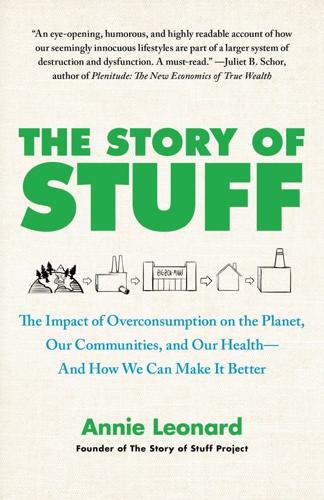
The Story of Stuff: The Impact of Overconsumption on the Planet, Our Communities, and Our Health-And How We Can Make It Better
by
Annie Leonard
Published 22 Feb 2011
To figure out where to plug in, I recommend that you take an inventory of your interests, passions, and skills and then look out in the world and see which organizations are a good match. If toxics in consumer products worry you, join or form a national campaign for chemical policy reform like the Safer States coalition in the Unites States. If healthy food systems are your passion, you might get involved with community-supported agriculture (CSA). My daughter’s school is a drop off site for a local organic farm’s CSA. Would that work where you live? If you’re sick of hearing your friends in Europe talk about their month-long vacations and leisure time, get involved in a national campaign for a shorter workweek and mandatory vacation law.
…
See individual chemicals Cheney, Dick, 247 Chevron, 30, 33–34 Child labor, 22, 49 Chile, 66 China, 5, 45, 49, 114, 142, 164, 180, 204, 243 Chlor-alkali plants, 54, 68, 75 Chlordane, 79 Chlorine, 48, 53–54, 56, 213 Chlorine dioxide, 54 Chromium, 44, 59, 73, 77 Chromium trioxide, 60 Chrysler Corporation, 164 Chungong Ayafor, Martin, 26–27 Chuquicamata copper mine, Chile, 21 Clark, Dana, 226 Clean Air Act (CAA) of 1963, 97 Clean Production Action, 60, 63 Clean Water Act (CWA) of 1972, 97 Clear-cutting, 7, 10–12 Climate change, 2, 12–13, 36, 50, 98, 246, 258 Clinton, Bill, 88 Closed-loop factories, 19 Coal, 20, 21, 35–36, 102, 207 Cobalt, 59 Coca-Cola Company, 196 Coffee, 14, 17, 169, 170, 172 Colborn, Theo, 45 Collapse (Diamond), 39–40 Coltan (tantalum), 27–29, 35, 246 Commercial Alert, 256 Community/citizen self, 173–177 Community forestry initiatives, 10, 41 Community-supported agriculture (CSA), 241 Composting, 198, 209–211, 233, 257, 261 Composting toilets, 12, 19 Comprehensive Chemicals Policies for the Future (Geiser), 101 Comprehensive Environmental Response, Compensation and Liability Act (CERCLA) of 1980, 97, 98 Computer TakeBack Campaign, 60 Computers, 57–64, 203, 206, 256 Computers and the Environment (Williams), 60 Conflict minerals, 25–29 Confronting Consumption (Maniates), 159 Connett, Ellen, 214 Connett, Paul, 183, 184, 214, 217, 232 Construction and demolition waste (C&D), 185, 199–201 Consumed: How Markets Corrupt Children, Infantilize Adults, and Swallow Citizens Whole (Barber), 169, 172 Consumer Product Safety Act of 1972, 96 Consumer Product Safety Improvement Act of 2008, 96 Consumer Products Safety Commission (CPSC), 96 Consumerism, defined, 145 Consumption, 144–181, 256 Container Recycling Institute, 67 Container ships, 113–114 Cook, Ken, 83 Copper, 20, 21, 59, 204 Corporate accountability, 257–258 Correa, Rafael, 30, 31 Cosmetics, 76–77 Costa Rica, 152, 244 Costner, Pat, 11–12 Cotton, 14, 17, 45–51 Council on Environmental Quality (CEQ), 95–96 Cradle to Cradle (McDonough), 52 Credit cards, 148, 151, 160 Cryolite (sodium aluminum fluoride), 65 Curare, 2 Cyanide, 15, 24 Davis, Mike, 26 DDT, 73, 79 Deca-BDE, 79–80 Declaration on the Rights of Indigenous Peoples, 38 DeClerq, John, 169 Deconstruction, 200 Defoliants, 48 Deforestation, 2–9, 52–53 Dell, Michael, 58, 110 Dell Computers, 58, 59, 62, 205, 206, 256 Democratic Republic of the Congo, 26–28, 35, 134, 152, 246 Depreciation, 182–183 Depression, 150 Dharma Bums, The (Kerouac), 6 DHL, 115 Diamond, Jared, 39–40 Diamonds, 20, 25–27, 35 Digital TV conversion, 202 Dioxin, 54, 69, 73, 79, 171, 209, 213 Disney, 49–50 Disposable goods, 162 Disposal, 182–236, 256–257 Distribution, 106–143, 255–256 Do Not Mail Registry, 9 Dora the Explorer, 166 Dow Chemical, 91 Downcycling, 231–232 Downshifting, 158–159 Droughts, 2, 16 Duales System Deutschland (DSD), 197 Dublin Principles, 18 Dumanoski, Dianne, 45 Durning, Alan, 181 Dyes, 48, 51 e-Stewards program, 206 Earth Economics, 242 Earth Overshoot Day, 153–154 Earthlife Africa, 222 EarthRights International, 33, 258 Earthworks, 21, 29, 253 Earthworms, 51 Ecological Footprint, 152 Economics of Ecosystems and Biodiversity, The, 5 Economist, The, 16 EcoPrint, 56 Ecuador, 30–31 EDC (ethylene dichloride) Ehrenreich, Barbara, 142 Eisner, Michael, 50 Electricity, 35 Electronic waste (e-waste), 58, 185, 202–206 Electronics, 27–29, 57–64, 120 Electronics TakeBack Coalition, 58, 63, 202, 206 Elemental chlorine free (ECF) process, 54 Elgin, Duane, 158–159, 181 Emergency Planning and Community Right-to-Know Act of 1986, 93, 98 Endangered Species Act (ESA) of 1973, 98 Ending the Depression through Planned Obsolescence (London), 161–162 Envirogenetics, 75 Environmental Health News, 260 Environmental justice (EJ) movement, 87–88 Environmental Justice Networking Forum, 222 Environmental Paper Network (EPN), 9, 56 Environmental Protection Agency (EPA), 36, 54, 79, 88, 95–98, 115, 185, 190–192, 208, 215, 219–220, 225, 229 Environmental racism, 87–89 Environmental Working Group (EWG), 81–83, 95 Erosion, 7 Essential Action, 31 Etienne, Yannick, 49, 50 European Union, 5, 29, 72, 82, 133, 211, 234 Executive pay, 126, 258 Extended producer responsibility (EPR), 197–199, 233–234, 256 Extraction, 1–43, 253–255 Extractive Industries Transparency Initiative (EITI), 39 Factor 10 Club, 41 Fair trade logo, 51 Farmers markets, 140–141 Federal Express, 115 Federal Food, Drug and Cosmetic Act of 1938, 96 Federal Insecticide, Fungicide, and Rodenticide Act (FIFRA) of 1947, 97 Federal Trade Commission (FTC), 231 Fence-line communities, 87–94 Fertilizers, 46 Financial crisis (2008–09), 5, 179, 184, 194 Fish, mercury in, 74–75, 95 Flame retardants, 60–62, 73, 79–80, 82–83, 169, 203, 261 Floods, 2, 4, 7, 12 Fluoride, 60 Food and Drug Administration (FDA), 77, 95, 96, 99 Food Quality Protection Act of 1996, 97 Ford, Henry, 159–160 Ford Motor Company, 164 Forest Stewardship Council (FSC), 10, 40, 253 ForestEthics, 9 Forests, 2–10 Formaldehyde, 48 Fox, Peter, 174 Frank, Robert, 179 Freecycle, 120 Friedman, Thomas, 126 Fungicides, 46–47 Gallagher, Kevin, 136 Gandhi, Mahatma, 22 Gap, The, 108, 109 Geiser, Ken, 99, 101 General Agreement on Tariffs and Trade (GATT), 128, 132 General Mining Act of 1872, 22, 254 General Motors Corporation, 164 Genuine Progress Indicator (GPI), 242 Germany, 31, 71, 197, 234, 256, 257 Global Anti-Incinerator Alliance (GAIA), 215, 216, 235, 257 Global Footprint Network (GFN), 152–153 Global Forest Coalition, 8 Global Mercury Partnership, 75 Global Trade Watch, 136 Global warming, 36 Global Witness, 25–27 Gold, 21, 23–25, 35, 75 Gold Rush of 1849, 24–25, 27 Golden Rules, 25, 34 Gone Tomorrow (Rogers), 228, 232 Good Electronics, 63 Good Jobs First, 122, 123 Goodell, Jeff, 36 GoodGuide, 62, 111–112, 140, 175, 184, 260 Government laws and agencies, 95–99 GRAVIS, 22 Great Depression, 128, 194 Green chemistry, 84, 105 Green Dot program, 197, 234, 256, 257 Green Press Initiative, 56 Greenhouse gases, 53, 65, 180, 186, 188, 235, 254 Greenpeace, 31, 62, 63, 91, 113, 222, 224, 225 Greenwashing, 187 Greider, William, 109 Greige goods, 116–117 Grey-water system, 17–18 Grossman, Elizabeth, 59–60 Grove, Andy, 58 Guernica Chemicals, 223 Guide to Green Electronics (Greenpeace), 62 H&M, 116–117, 118, 120 Haiti, 4, 49–50, 51, 132, 137–139, 178–179, 224–227 Halogens, 48 Hanger Network, 165 Happiness/unhappiness, 149–155 Happy Planet Index, 151–152, 242, 244, 251 Hardrock Mining and Reclamation Act of 2, 22 Hawken, Paul, 241, 245, 250 Hazard Ranking System, 98 Hazardous waste, 201, 208 Health care, 122, 247 Health Care Without Harm, 202 Heap leaching, 24 Helfand, Judith, 175–176 Heptachlor epoxide, 79 Herbicides, 46 Hewlett-Packard (HP), 59, 206, 256 Hexachlorobenzene, 79 Hexavalent chromium, 30 High Tech Trash (Grossman), 59–60 Hoekstra, Arjen, 17 Hollender, Jeffrey, 234 Home Depot, 9 Human Rights Watch, 258 Humus, 11 Hunger, 178–180 Hydrochloric acid, 61, 69 Hydrofluoric acid, 60 Hydrogen chloride, 69 Hydrogen fluoride, 61 Hydrologic cycle, 2 Hydroxide, 60 Hydroxyl monoethanolamine, 60 IBM Corporation, 59 Iceland, 66 Incineration, 212–217, 224, 235, 257 Index of Sustainable Welfare, 242 India, 4, 5, 21, 22, 45, 47, 86–87, 90–93, 129, 134–135, 153, 165, 180, 193, 202, 236 Indigenous communities, 4, 37–38, 245 Individual actions, 239–241, 260–264 Industrial Revolution, 101, 102, 156 Industrial waste, 185–189 Infertility, 45 Inglewood, California, 126–127 Inkworks Press, 56 Insecticides, 46–47 Institute, West Virginia, 93 Institute for Local Self-Reliance, 34, 229 Integrity in Science Project, 99 Inter-American Development Bank, 132 Interface, 19, 185, 187–189 International Agency for Research on Cancer, 54 International Campaign for Justice in Bhopal, 92, 259 International Chamber of Commerce, 228 International Conference on Water and the Environment, 18 International Council on Mining and Metals, 227 International Energy Agency (IEA), 29–30 International financial institutions (IFIs), 127–136, 139–140 International Labour Organization, 8, 21–22 International Monetary Fund (IMF), 38, 39, 128–131, 140 International waste dumping, 219–227 International Working Group for Indigenous Affairs, 38 Inventory, elimination of, 110 Ipecac, 2 Iraq, 243, 244 Iron, 20, 44, 59 Irrigation, 46 Isopropyl alcohol, 60 Jensen, Rhonda, 194 Jewelry, 23–25 Jones, Van, 6, 207 Jubilee debt campaign, 130, 131–132 Junk mail, 9 Just-in-time (JIT) model, 110 Kasser, Tim, 151 Katzen, Mollie, 158 Keep America Beautiful (KAB), 196 Kenya, 130 Kerouac, Jack, 6 Khian Sea (cargo ship), 224 Kid-Safe Chemicals Act (KSCA), 82, 83, 255 Kimberley Process, 26–28, 34, 253 King, Oona, 28 Knapp, Dan, 190 Knight, Phil, 109 Korten, David, 109 Kovalam, India, 236 Kyoto Protocol, 66 Lambrecht, Bill, 222 Landfills, 69, 207–209, 211–213, 235 Lane, Eric, 173 Lawns, 14 Layard, Richard, 176 Leachate, 207–209 Leaching (off-gassing), 69, 70 Lead, 15, 24, 34–35, 42, 59, 61, 69, 72, 73–74, 76–77, 79, 86, 91, 203, 205, 219 Lean manufacturing, 108–110, 116 Lean retail, 110–111, 117 Lebow, Victor, 160 Lerner, Steve, 89 Light-weighting, 41 Lightolier, 218 Lignin, 53 Lipsticks, 76–77 Lithium, 61 Local food movement, 140–141 Logging, 7–8 London, Bernard, 161–162 Lovera, Simone, 8 Lustgarten, Rita, 174 Luxury Fever (Frank), 179 MacKinnon, J.

Organized Simplicity
by
Tsh Oxenreider
Published 3 Nov 2010
Food, Inc. distributed by Magnolia Home Entertainment. A compelling documentary about the modern-day food industry. Slightly graphic for young children. How to Cook Everything: 2,000 Simple Recipes for Great Food by Mark Bittman, published by John Wiley & Sons, Inc. Local Harvest, www.localharvest.org. A database of farmers’ markets, community supported agriculture (CSA), and local farms. Nourishing Traditions: The Cookbook That Challenges Politically Correct Nutrition and the Diet Dictocrats by Sally Fallon and Mary G. Enig, published by NewTrends. Real Food Media, www.realfoodmedia.com. A network of bloggers who promote slow food, whole ingredients, and traditional cooking methods.

The Zero Marginal Cost Society: The Internet of Things, the Collaborative Commons, and the Eclipse of Capitalism
by
Jeremy Rifkin
Published 31 Mar 2014
Dell adds that “we are a free service. We have no business model!” A correction: SharedEarth does have a business model—it’s called the Commons.52 While gardeners are beginning to share harvests on microplots, a younger generation of farmers is sharing harvests on an agricultural scale with urban consumers. Community supported agriculture (CSA) began inauspiciously in Europe and Japan in the 1960s and accelerated rapidly in the United States and other countries in the 1990s with the rise of the Internet. Urban consumers pledge a fixed amount of money to local farmers in advance of the growing season to pay for the up-front cost of growing the crops.
…
M., 34 Center for Strategic and International Studies (CSIS), 292 Cha, Ariana Eunjung, 169 Chakrabarty, Ananda, 165 Chandler, Alfred, 44, 46 Chronicle of Higher Education (Carey), 118–119 Church, George, 86 Cisco, 14–15, 73, 149 clean IT. see Cleanweb Movement Cleanweb Movement, 145–147, 172 Clemens, Eric, 250–251 climate change, 286–291 Clinton, President Bill, 7, 164, 188 Coase, Ronald, 137, 150–151, 207–208, 211 collaborative age, 76–77, 86, 107–110, 131, 151, 217, 230, 302, 311 classrooms. see massive open online courses (MOOCs) consumption, 234–238, 253, 282 etymology of, 18–19 freedom, 226 rise in collaborative innovation, 21 Collaborative Commons, 153–222 collaboratists prepare for battle, 173–192 and comedy of the commons, 155–172 and the communications commons, 195–205 and the cooperatives’ renaissance, 211–217 definition of, 16 and healthcare. see healthcare historical background of, 16–17 importance of, 17–18 and logistics commons, 217–221 and managing temporal resources, 221–222 the medium is the domain, 177–181 and a new commons narrative, 181–187 and the new deal’s greatest success, 206–211 and protests to reclaim the public, 187–188 rise of the, 16–25 as a self-managing economic enterprise, 16 shift from exchange value to sharable value, 19–20 and the struggle to define and control the intelligent infrastructure, 193–222 as technological soul mate of the IoT, 18 see also the comedy of the commons; social capital and the sharing economy the comedy of the commons, 155–172 design principles of effective commons, 161–162 rediscovering, 156–165 and Törbel Commons covenant agreement of 1483, 160–161 see also Hardin, Garrett; Rose, Carol “Commons affliction,” 187 Community supported agriculture (CSA), 239–240 computer-aided design (CAD), 124 computer(s), cost(s) of, 80 concentration patterns, 54–55 conservation easement(s), 186 consumer(s) and access over ownership, 20 society, 22, 208, 233, 247, 299 contour crafting, 96 contradiction between intellectual-property rights and open-source access, 100–101 copyright(s), 175, 178–181, 188 and “copyleft,” 175, 179, 253 see also patent(s) Couchsurfing, 235, 237, 258 Coursera, 115–118 currencies, alternative, 259–262 Craigslist, 249 Crane, David, 83 Creative Common licenses, 94, 179–180, 186 crowdfunding, 19, 146, 256–257, 269 crowdsourcing approach to research, 116, 242–243 cyber attacks/cyberterrorism, 286, 291–296 cyber thieves, 76 Darwin, Charles, 63–64, 183 data security and privacy, associated with IoT,14 Defense Advanced Research Projects Agency (DARPA), 125 Dell, Adam, 239 DeLong, J.
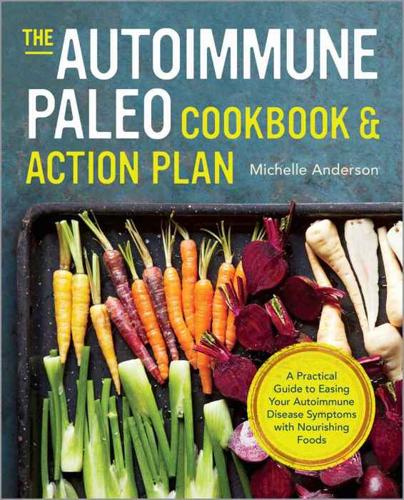
The Autoimmune Paleo Cookbook & Action Plan: A Practical Guide to Easing Your Autoimmune Disease Symptoms With Nourishing Food
by
Michelle Anderson
Published 24 Dec 2014
Flash-frozen vegetables lose very few nutrients in the freezing process, and since they are usually frozen when they’re ripe, you get quality produce. Frozen vegetables are less expensive than fresh, and you can use exactly what you need and put the rest back in the freezer, which cuts down on waste. 10 Join community-supported agriculture (CSA) programs or farm shares. A CSA is a plan in which you buy a share of a local farmers’ produce. After that expense, you will enjoy farm-fresh produce delivered right to your door or to a convenient drop-off location all season long. This arrangement means you get seasonal fruits and vegetables at a much lower price than you would pay in the store.
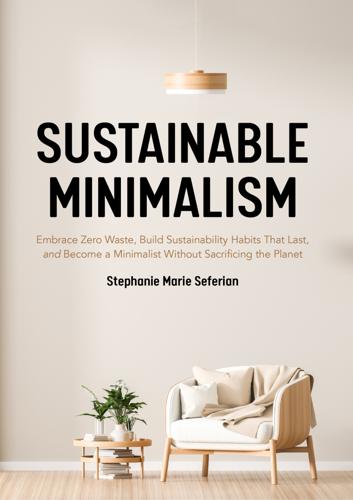
Sustainable Minimalism: Embrace Zero Waste, Build Sustainability Habits That Last, and Become a Minimalist Without Sacrificing the Planet (Green Housecleaning, Zero Waste Living)
by
Stephanie Marie Seferian
Published 19 Jan 2021
My local Middle Eastern store encourages me to load up on olives, spices, and even cheese in my own jars. You can find stores with bulk bins near you by visiting Zero Waste Home’s web-based BULK app. Remember your local produce and dairy farms! My family is fortunate to have an organic farm within miles, and we’ve invested in the farm’s future by signing up for their Community Supported Agriculture (CSA) program. I appreciate that CSA programs provide my family with ultra-fresh vegetables. On many pickup days, farmers have picked our produce just hours before we arrive. I often walk my community’s weekly farmer’s market, too, because it boasts a wide array of food items from fruits and vegetables, to eggs, meats, and even flowers, all without plastic.
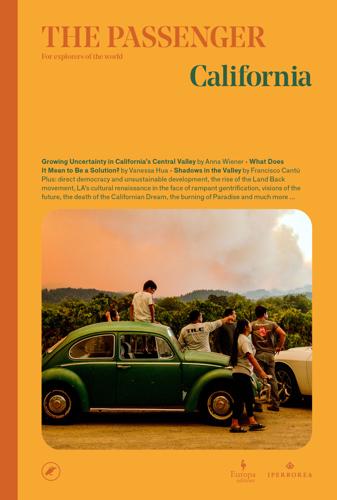
The Passenger
by
AA.VV.
Published 23 May 2022
When the whales finally left, in late December, Pacific Seafood, a major West Coast wholesaler, announced that it would be offering an unusually low price for Dungeness crab because the company still had plenty frozen from the previous year’s catch; this resulted in a sort of unilateral strike among fishermen, although they have no formal union. For some farms, of course, the pandemic created new and occasionally lucrative opportunities. Smaller farms, such as those specializing in organic or heirloom produce, could be nimble. Some created farm-box and Community Supported Agriculture programs; others launched e-commerce sites or worked with regional grocery-delivery companies. Early on in the pandemic, I began picking up farm-boxes offered by an organic farmer with land in the Salinas Valley who had sold directly to Bay Area restaurants for the past thirty years. Some weeks, the cardboard box contained items that I had never seen before: sudachi, cardoons, flowering coriander.

Empire of Things: How We Became a World of Consumers, From the Fifteenth Century to the Twenty-First
by
Frank Trentmann
Published 1 Dec 2015
UNSER Land was solidarity in action, uniting local producers, retailers and consumers – not forgetting the animal kingdom, with dog food made from local beef and chicken, untouched by genetic technology.42 The Bavarian UNSER Land network, which originated in Fürstenfeldbruck in 1994, is just one of a large number of regional and local food initiatives that have sprouted across the West since the late twentieth century. ‘Slow food’ has radiated outwards from its original home in Northern Italy to over a hundred countries. From New Mexico to New England, America is now peppered with community-supported agriculture (CSA) groups. Unknown in England before 1997, today, over five hundred farmers’ markets set up their stalls, week after week. Urban gardens in Paris and New York, food-box deliveries in Bristol, award-winning restaurants in Copenhagen that serve locally foraged mushrooms – the quest for authenticity in local food appears unstoppable.
…
‘I’m quite keen on supporting smaller local producers,’ one English woman explained, ‘because I think that way you get diversity, more competition and different qualities . . . it is a way of making sure we maintain choice.’ 65 This is a far cry from the dull and repetitive diet that ruled when food was really local. Tellingly, the regional market of Carpentras today offers greater variety in winter than in summer.66 Commentators like to stress the potential of local food networks. It is equally important to recognize the limits of people’s commitment. In the United States, Community Supported Agriculture initiatives have found it difficult to survive once the enthusiasm of the first harvest is over. For many members, a CSA is little more than a food-buying club. In New Mexico, they lose half their members every year.67 ON THE MOVE Fernando Sánchez left his native Mexico for Los Angeles in the 1920s.
…
Schramm, Konsum und regionale Identität in Sachsen, 1880–2000: Die Regionalisierung von Konsumgütern im Spannungsfeld von Nationalisierung und Globalisierung (Stuttgart, 2002); and La Repubblica, 13 Feb. 2013, 29–31. 63. http://instoresnow.walmart.com/Food-Center-locally-grown.aspx. 64. Susanne Freidberg, Fresh: A Perishable History (Cambridge, MA, 2009). 65. Quoted in Kirwan, ‘Reconfiguration of Producer–Consumer Relations’, at 155. 66. De la Pradelle, Market Day in Provence, 111–13. 67. Lois Stanford, ‘The Role of Ideology in New Mexico’s CSA (Community-supported Agriculture)’, in: Wilk, ed., Fast Food/Slow Food: The Cultural Economy of the Global Food System, ch. 12. 68. Quoted from Manuel Gamio, The Mexican Immigrant: His Life-story (Chicago, 1931), 68. 69. Manuel Gamio, Mexican Immigration to the United States (Chicago, 1930), 67–9 and appendix V. 70. World Bank, Migration and Development Brief, no. 19 (20 Nov. 2012). 71.
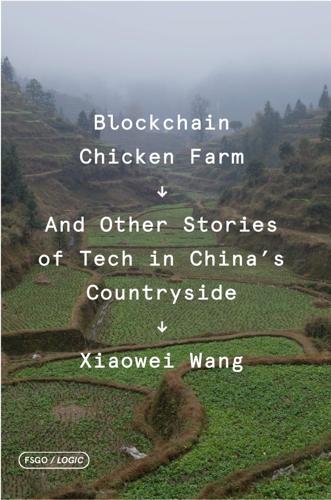
Blockchain Chicken Farm: And Other Stories of Tech in China's Countryside
by
Xiaowei Wang
Published 12 Oct 2020
People come around twice a week in cars, selling us pork, including the preserved pork you’re eating. It’s so much cheaper to buy pork than to raise your own. You’d be an idiot to raise your own.” Through friends, I manage to get in contact with just such an idiot named Li Jianhu, who runs an ecological pork CSA (community-supported agriculture) operation in Fujian. He’s plugged into the small-scale organic pork farming scene in southern China, so I’m hoping he can help me find a pig farm to visit. He says he’ll ask around, but no promises. Security is tight. African swine fever is serious. Jianhu explains that the virus is typically spread from snout-to-snout contact in wild boars, but has now infected domesticated pigs.

The omnivore's dilemma: a natural history of four meals
by
Michael Pollan
Published 15 Dec 2006
If there was a dark side to Joel's vision of the postindustrial food chain, I realized, it was the deep antipathy to cities that has so often shadowed rural populism in this country Though when I pressed him, pointing out that New York City, den of pestilence and iniquity though it might be, was probably here to stay and would need to eat, he allowed that farmer's markets and CSAs—"community supported agriculture," schemes in which customers "subscribe" to a farm, paying a few hundred dollars at the start of the growing season in exchange for a weekly box of produce through the summer—might be a good way for urbanités to connect with distant farmers. For my own part, this taut little exchange made me appreciate what a deep gulf of culture and experience separates me from Joel—and yet at the same time, what a sturdy bridge caring about food can sometimes provide. 2 4 5 246 * THE O M N I V O R E ' S DILEMMA (Sometimes, but not always, for the antipathy of city and country still runs deep—and in both directions.
…
INDEX abalone, gathering, 394—96 Ableman, Michael, 169 Adams, Bud, 188 Adams, John, 101 ADM (Archer Daniels Midland), 5 2 , 63, 86-87,93,95, 154 Agricultural Testament, An (Howard), 145—46, 149 agriculture: alternative, 8, 143-45, 249-50 corporate functions in, 63 department, see Department of Agriculture, U.S. and evolution, 2 3 , 129, 267 exports, 5 1 , 53, 62, 63 food chain modified by, 6-7, 5 2 government policies in, 39, 4 1 , 48-50, 51-53,61-63,67, 103, 108, 154, 182,200-201,241,243 hunting-gathering vs., 279—80, 320 individual farms in, 34—35; see also farming industrialization of, see industrial food chain natural world reshaped by, 10, 2 4 , 62 need for, 10 perverse economics of, 48, 53—55, 61-63, 117 premodern systems of, 145, 191 solar energy in, 70, 188-89, 199 surpluses in, 49-50 yields in, 2 5 , 103, 147 Alar scare, 1 5 2 - 5 3 , 154 alcohol, corn as source of, 2 5 , 100—101 Alcoholic Republic,The (Rorabaugh), 100 algae, 4 7 , 8 3 , 2 6 9 alpha linolenic acid (ALA), 267 amanita, 376, 377 AMC (argument from marginal cases), 308,311-12 American paradox, 3-5 amino acids, 20, 42 ammonium nitrate, 4 1 , 4 4 Animal Liberation (Singer), 304, 307-9, 328 animal rights: and animal happiness, 319—25, 328 and animal suffering, 308, 310, 312-13,315-19,328 arguments with, 309—13 ignorance of nature in, 320, 321 increasing activism in, 305, 309 and individual vs. species, 3 2 3 - 2 5 and laboratory testing, 312 and marginal cases, 308, 311—12 and prédation, 321—23 vs. speciesist viewpoint, 308—9 and vegetarianism, 305, 3 1 3 - 1 5 , 319, 325-27 animals: birds working with, 126, 2 1 1 , 2 1 5 in CAFOs, 67-68, 128, 130, 1 8 2 , 2 5 3 , 317 cruelty to, 2 5 5 domesticated, 10, 310, 320 438 * INDEX animals (cont.) evolution of, 23 factory-farmed, 39, 64, 118, 140, 2 5 4 , 306,310,317-19 feed affecting taste of, 177 in feedlots, 65-84 grass-eating, 70, 126-28, 130, 186-91, 208-56, 267 happiness of, 3 1 9 - 2 5 , 327 human relationships with, 10, 306—7, 320,333,357-58,401 lacking souls, 3 1 5 , 3 3 1 - 3 2 , 358 learned helplessness of, 218 life expectancy of, 321 meat from, see meat mystery of, 359 in organic systems, 149 sacrificial, 331 slaughter of, 7 1 , 81, 2 2 7 , 228-30, 2 3 5 - 3 6 , 304, 329-33 as species vs. individuals, 323—25 suffering of, 308, 310, 3 1 2 - 1 3 , 315-19,328 sweet tooth of, 106 in the wild, 3 2 1 - 2 3 Appetite for Change (Belasco), 141—44 Aristotle, 298, 320 Arora, David, 374 artisanal economics, 249—50 ascorbic acid, 18 Atkins, Robert C, 2 atrazine, 59, 132, 178 Aztecs, maize revered by, 58, 119 bacteria, 128, 160, 229-30 Baily, Ben, 380-85, 387, 389, 390 beef tallow, 74, 76 Belasco, Warren J., 141—42 Bell, Daniel, 302 Bell Institute, 92 Bentham, Jeremy, 308, 328 Berger, John, 306,323, 359 Berry, Wendell, 11, 68, 145, 220, 254, 259 Bing cherries, 397-98, 399 biodiesel fuel, 164 biodiversity, 9, 410 on organic farms, 161, 197, 2 2 4 , 255 shrinking, 47 in supermarkets, 16-17 biophilia, 128 bison, 2 4 , 70, 3 2 2 - 2 3 Blair, Ed and Rich, 68, 71, 72, 76-77 Blair Ranch, South Dakota, 68-72, 77 Blank, Steven, 2 5 5 - 5 6 blue baby alerts, 47 Bosch, Carl, 43 Bové, José, 255 bovine spongiform encephalopathy (BSE), 75-76 Brillat-Savarin, Anthelme, 3, 270, 2 7 2 , 291,295 Brix scores, 176 Budger (cow), 193, 196-97, 198 Budiansky, Stephen, 316 Butz, Earl "Rusty," 5 1 - 5 2 , 103, 201 CAFOs (Confined Animal Feeding Operations) : and cheap corn, 67-68, 200, 253 and fossil fuels, 73 in industrial food chain, 128, 130, 182, 200,317 learned helplessness in, 2 1 8 manure lagoons of, 79, 130 Cal-Organic Farms, 138n, 1 7 3 , 1 7 4 - 7 5 calories, 75 cheap, 1 0 7 - 8 , 1 1 7 daily intake of, 102 as energy, 2 1 - 2 2 , 106, 108, 118 in fast food, 1 1 2 , 118 overproduction of, 103, 108 cannabinoids, 342 cannibalism, 76, 298, 358 Capay farms, 138 capitalism, cultural contradictions of, 318 caramel color, 19 carbohydrates, 20, 86, 91, 118, 179, 266, 291 carbon, 2 0 - 2 2 , 4 2 , 47, 117, 197 carbon dioxide, 20 carbon isotopes, 20, 2 2 , 116 carbophobia, 1-2 Cargill, 5 2 , 63, 69, 86-87, 93 Cascadian Farm, 144-45, 1 5 1 - 5 3 , 154, 156, 162, 173-74 Case for Animal Rights, The (Regan), 323 cassava, 293, 294 INDEX cattle: and cheeseburgers, 114—15, 117 corn fed to, 66, 7 1 , 74-75, 77-78, 82, 84, 200 cow-calf operation (Blair Ranch), 68—72 in a "cow day," 191 diseases of, 75-76, 77-78, 237 drugs fed to, 71, 73, 74,76, 78-79,81, 178 eating cattle, IS—77 and electric fences, 193 on the farm, 38, 39, 193-97,317 fattening up, 75, 81, 200 on feedlots/CAFOs, 39, 65-68, 72-84, 139, 194,200-201 grass fed to, 70, 75, 82, 83, 126, 186-91, 194-95,269 protein matter fed to, 74-77 range-fed, 134-35 ratio of feed to flesh in, 81, 115 rumens of, 70, 72, 74, 75, 78, 82, 187, 193, 197,290,326 slaughter of, 7 1 , 8 1 , 3 2 9 - 3 3 stress-free, 135 supplements fed to, 71, 74 weaning of, 71—72 chamomile, 398 chanterelles, 285-86, 366-70, 380, 406 chemical fertilizers, 4 1 - 4 7 , 68, 146-49, 151,220 chemical pesticides, 45, 143, 148, 152-53, 177,212,220-22 Chez Panisse, Berkeley, 253 Chicago Board of Trade, 60 chicken: in grass-fed meal, 262-66, 269—71 Maillard reaction in, 270 McNuggets, 10,95, 110, 1 1 1 - 1 4 , 115-18 in microwavable TV dinner, 139-40, 173-74 popularity of, 114 price of, 235 chickens: as cattle feed, 76 eggs produced by, 126, 135, 170-71, 211,212,213,251,252,262,269, 317,318 factory life of, 39, 171-72, 182, 317-18 on the farm, 38,39, 126, 140, 169-73, 182,210-13,215,216,221,319, 321 Gallus gallus, 10 killing, 226-38, 250, 332 local markets for, 241—42 organic, 170, 182 ratio of feed to flesh in, 81, 115 Child, Julia, 265 China, fertilizer factories in, 43 citric acid, 86 Cobbett, William, 26, 101 Coca-Cola, 95, 104-5 CoetzeeJ.M, 309,319 Columbus, Christopher, 2 4 , 104, 338 commune movement (1960s), 141—44, 152, 154 community supported agriculture (CSA), 153,245,257,259 conjugated linoleic acid (CLA), 267 cooking, food chain modified by, 6 corn, 32—56 botanical parts of, 86, 87 C-4, 21-22, 104 cheap, 47-50, 5 1 - 5 2 , 5 3 - 5 4 , 67-68, 74, 7 5 , 8 2 - 8 3 , 9 5 , 101, 103, 108, 117, 118, 199-200,253 and chemical fertilizers, 41—47 cities of, 37-38, 118-19 as commodity, 26, 34, 49, 58-63, 64, 6 6 , 6 7 , 7 3 , 8 4 , 9 3 , 103 dependence on humans, 26—28 developing new uses for, 87, 90 eaten as corn, 85 evolution of, 2 3 - 2 6 , 29-30, 60 exports of, 5 1 , 53, 62, 63 F-l hybrids, 36-37, 104 in fast food, 113 in feedlots, 73, 74-75, 82-84, 200 as foundation of food chain, 18—19, 31, 5 1 , 117 genetically engineered, 3 6 genetic variability of, 25 Golden Bantam, 265—66 government and, 4 1 , 48-50, 67, 74, 103, 108,200-201 grading system for, 60, 200 * 439 440 * INDEX corn (cont.) and grain elevators, 57, 59—61, 63, 86 hybrid, 2 9 - 3 1 , 37, 4 1 , 42, 45 as intellectual property, 30—31,92 kernels of, 86 the meal, 109-19 monoculture of, 8, 38-40, 65, 67, 83, 119,410 in nonfood products, 19 Pioneer Hi-Bred 34H31,36,59 planting, 35-36, 37, 128 pollen, 28-29 prices of, 39, 40, 47-50, 53-56, 60-63, 67, 74, 101, 103 processed foods from, 91-92 processing of, 85—99 quality of, 59, 60 rise of Ztamays, 2 3 - 2 6 , 60, 104 sex change of, 2 7 - 2 8 , 104 sex life of, 28-31 starch in, 87, 88, 89, 98-99 style of, 28 in supermarket, 15—19 surfeit of, 57-58, 62, 67, 74, 101, 103 tassel, 28 usage of, 26 walking, 19-23 yields of, 2 5 , 30-31, 36-37, 39, 4 2 , 4 5 , 46,50,60 corned beef, 25 cornmeal, 85, 86, 93 corn oil, 86,88 cornstarch, 88, 93, 96 corn sweeteners, 18 corn syrup, 88, 89 corn whiskey, 25, 100-101, 104 cows, see cattle Cultural Contradictions of Capitalism,The (Bell), 302 Cuyahoga River, on fire, 142 cyclodextrins, 86 dairy products: and bovine lifestyle, 135-36, 139, 158 organic, 156, 158, 178, 182, 267 Darwin, Charles, 150 Dawson.Todd, 2 3 , 116 DDT, 1 4 1 - 4 2 , 3 2 4 Dennett, Daniel, 3 1 6 , 3 1 7 Department of Agriculture, U.S.: and cheap corn, 5 1 - 5 2 , 74 direct payments to farmers from, 52, 61-63 and entrepreneurship, 246—47, 250 and irradiation of meat, 82, 230, 250 meat graded by, 75, 200 and organic farms, 145, 154—57, 178-79 price supports from, 5 2 , 53, 83 and slaughtering animals, 227, 228—30, 235-36 Descartes, René, 306, 315 Des Moines River, pollution of, 46—47 dextrins, 86 dextrose, 18, 88, 89, 116 diabetes, 102, 107, 117 diets, fads in, 1—3 Diggers, 141 disgust, 292, 355-59 domesticated species, 10, 29-30, 310, 320 Drucker, Peter, 188 eagles, 324 Earthbound Farm, 138, 162-68, 173, 174-75, 176, 182, 183 earthworms, 127, 147, 196, 216 eating: in cars, 109, 1 1 0 - 1 1 , 1 1 7 , 1 1 9 change in national habits of, 1-3, 298-302 as dining, 2 7 2 ethics of, 280-81, 304-13, 405 family dinners, 302 food fads, 1-3,299-301 generalists in, 4; see also omnivore 's dilemma and grace, 407 industrial, 10 low on food chain, 118 and obesity, 62-63, 100, 101-2 paradox of, 3 - 5 , 405 the perfect meal, 405-10 Eatwild.com, 248 EcoFriendly Foods, 2 4 2 E.coliO157:H7, 62, 82, 83,250 ecology, 7 , 4 7 , 6 2 , 143, 161 Eggleston, Bev, 242, 246-50, 260 I N D E X * 44 1 elements, fixing, 4 2 , 45 Emerson, Ralph Waldo, 2 2 6 End of Agriculture in the American Portfolio, The (Blank), 2 5 5 - 5 6 energy: in calorie form, 2 1 - 2 2 , 106, 108, 118, 199 in carbohydrates, 291 cheap, 200 in food processing, 118 solar, 2 1 - 2 2 , 4 4 , 4 5 , 70, 73, 83, 188-89, 199 energy density, 10 7—8 Enriching the Earth (Smil), 42 enzyme hydrolysis, 89 essential fatty acids, 267-69 ethanol, 62, 86, 90, 103, 111, 116 evolution: adaptation of species in, 10, 30, 119, 320,385 and agriculture, 2 3 , 129, 267 and appetite elasticity, 106 cannibalism in, 76 Darwinian trial and error, 30 of domesticated species, 10, 29-30 and food chain, 6, 103-4, 280 industrial thinking vs., 68 natural selection in, 150-51, 180, 280, 288,289,320,342 sex change in, 2 7 - 2 8 Excel, 69 factory farms, 45 alternative food chain vs., 13 0-31 animals on, 39, 64, 118, 140, 2 5 4 , 306, 310,317-19 antibiotics used in, 73, 78-79 economic logic of, 75, 81, 139 excess production by, 62-63 and human health, 67 and organic food, 156-69 pollution from, 46-47, 67, 2 0 1 , 2 5 5 productivity as goal in, 46, 318 Fallon, Sally, 248 farmer's markets, 2 4 5 , 246-49, 2 5 7 , 259, 260 farming, 32—56 artisanal production, 249—50 buyers of the crops, 59, 60, 240 chemical fertilizers in ,41— 4 7, 68, 148, 151,220 chemical weed killers in, 40 closed ecological loop in, 68 corn, see corn corporate benefits from, 36, 63, 95, 201 crops owned in, 59 direct purchase from, 240—42, 2 4 4 , 2 4 7 - 4 8 , 2 5 4 , 256 diversity in, 38-39, 4 5 , 67-68, 161, 258 economic problems of, 94, 119, 138, 161 electric fences in, 193, 206 fewer people in, 40 fish, 18,268-69, 280 "good farm," 3 2 7 - 2 8 , 3 3 2 - 3 3 government policies in, 39, 4 1 , 48—50, 5 1 - 5 3 , 61-63, 83, 103, 108, 182, 200-201,227,241, 243,246 and grain elevators, 59—61, 63 grass, see grasses income from, 3 4 , 53—56, 61-63, 95 industrial management in, 4 5 , 5 2 , 138 integrity in, 240—41 intellectual work of, 220 monocultures of, 8, 38-40, 4 5 , 65, 67, 83, 119, 129, 162, 1 6 4 - 6 5 , 2 1 4 , 221,258,410 Naylor curve, 53—56 organic, see organic farming pests in, 149-50, 151 and populists, 50, 245 productivity in, 3 4 , 36, 5 2 , 5 3 , 101, 103, 118, 161, 197-98,213,222, 249 relationship marketing in, 240, 2 4 2 , 244, 247 soil for, 3 3 , 4 1 - 4 2 , 127, 146-47 sustainable, 131-33, 160, 161, 169, 183-84, 198-99, 230, 240, 327, 411 yields in, 32, 36-37, 60, 136 fast food: appeal to children, 111 chemicals in, 113—14 eating in the car, 109, 110-11, 117, 119 g e n e r i c f r a g r a n c e a n d flavor of, 1 1 1 4 4 2 * INDEX fast food (cont.) at McDonald's, 105-6, 109-19, 259, 329,330,411 meal of, 109-19 supersizing, 105-6, 110, 117 fat, dietary, 179,267 feedlots, 65-84 as animal cities, 73 antibiotics on, 73, 78-79 commodity corn in, 39, 73, 74—75, 82-84,200-201 feed mill, 7 3 - 7 4 fossil fuels in, 73 manure lagoons in, 79, 130 organic, 139 pen 63 in, 79-84 pollution in, 68, 79 sick cows in, 77-79 waste products of, 79, 83 see also CAFOs; factory farms fertilizers: chemical, 4 1 - 4 7 , 68, 146-49, 151, 220 and crop yields, 44—45 fossil fuels in production of, 4 4 Haber-Bosch process, 4 3 , 47 manure, 4 2 , 2 1 0 , 2 1 1 , 2 1 3 , 2 1 6 N-P-K formula of, 146-49, 180-81 in organic farming, 160, 165—66 pollution from, 46-47 fish: as cattle feed, 76 farmed, 18,268-69,280 reengineering, 18, 67 wild, 135,269 fishing, 279-80, 339, 365 Flannery,Tim, 323 Fletcherizing, 299 food: abstract, 112, 1 1 4 - 1 5 , 119 cheap, 103, 117, 1 3 6 , 2 0 0 , 2 4 3 cooking of, 293, 294 energy cost of, 107—8 fads, 1-3,299-301 and fixed stomach problem, 94, 117 genetically modified, 36, 152, 154, 255 globalization of, 255 hidden costs of, 2 4 3 - 4 5 , 250, 281 and human nutrition, 179—81, 266—68 industrialization of, 62, 93-94, 249 liberated from nature, 90-94, 9 5 , 1 1 2 , 114 macronutrients in, 179-81, 267-69 as metaphor, 2 5 5 , 257, 411 national cuisines, 295, 299, 301, 303 neutraceutical, 93 processed, 90-99, 106-7, 115, 118, 152,243,301 quality of, 2 4 4 , 251 separation of producer from consumer, 60, 153 storied, 134-36, 1 3 7 - 3 9 , 4 1 1 synthetic, 97, 98, 143, 177-78 taboos of, 296, 298, 357, 358 Food and Drug Administration (FDA), 76 food chain: biological systems at ends of, 9 connectedness of, 146, 149, 151, 2 1 3 , 214,226 eating low on, 118 and evolution, 6, 103-4, 280 forests in, 388-89 foundations of, see corn; grasses of hunter-gatherers, 280-81, 362-63 imbalance in, 62 industrial, see industrial food chain local, 236, 2 3 9 - 4 2 , 249, 262 modifications of, 6—7, 5 2 in nature, 6, 62, 2 1 4 - 1 5 , 388-89, 405 obscurity of, 3 4 - 3 5 , 195 perfect meal at end of, 399 reinvention of, 7, 260—61 scientific investigation of, 20, 2 2 - 2 3 , 116-17 solar-powered, 70—71 food industry: and consumer expectations, 139, 184 and food fads, 301 and government, 82 growth rate of, 94—95 industrialization of, 7, 93-94, 117; see also industrial food chain and omnivore 's dilemma, 5 selling convenience, 96, 301 substitution in, 95 supersizing in, 105-6, 117 value added in, 95-98, 103, 152 food poisoning, 62, 152 food scares, 152—53 INDEX * 443 food science, 107, 111 food security, 64, 92 food systems, 93, 240 alternative, 143, 149-50, 153, 154, 246, 249 connectedness of, 146, 153 consumers in, 95, 139, 184, 245, 258-60 distribution in, 138, 153, 2 5 0 - 5 2 , 259 energy density in, 107—8 local, 153, 240-45, 247-49, 2 5 2 - 5 4 , 257-59, 260, 262 foraging: for abalone, 394-96 for mushrooms, see fungi forbs, 127, 195 forests: biological processes at work in, 149 in food chain, 388-89 mushrooms in, see fungi renewal of, 388 fossil fuels: in chemical fertilizers, 44, 45 consumed in processing food, 83—84, 88, 117, 167, 182-84 consumed in transporting food, 183, 240, 249 converted to food, 45-46, 83-84 and global warming, 198 in industrial food chain, 7, 30, 73, 83-84, 1 8 2 - 8 4 , 2 4 9 from Middle East, 83 Francis, Saint, 305 Franklin, Benjamin, 310, 327 French paradox, 3, 300-301 Freud, Sigmund, 298 fructose, 18, 86, 89, 107 Fry, Gearld, 188 fungi: autochthonous nature of, 374 chanterelles, 285-86, 366-70, 380, 406 chlorophyll lacking in, 374-75 eating, 370-71 foraging for, 278, 365-70, 379-85, 386-90 as hallucinogens, 373, 376 hyphaeof, 374, 375 identifying, 3 7 1 , 3 7 2 morels, 378-85, 386-90, 394, 396, 408 mycelium of, 127, 374, 375, 378 mycorrhizal, 147, 374, 375, 387 mysteries of, 373-78, 384 organic matter decomposed by, 375—76 poisons in, 278-79, 366, 370-71, 373, 376 saprophytic, 374, 375, 387 theories about, 383-84, 387 types of, 377 Gandhi, Mohandas K., 305 gardening, 365-66, 385-86 Garro, Angelo, 2 8 2 - 8 4 dressing the meat, 354—57 as food lover, 339, 354, 356, 392 mushroom hunting with, 366—70, 371 and perfect meal, 392, 396-97, 398, 400-401,404,405-8 pig hunting with, 335-36, 337,338, 340-42, 344-45, 347, 349-54 General Mills, 92, 93, 94, 95, 96, 144-45, 151 genetically modified organisms (GMOs), 36, 152, 1 5 4 , 2 5 5 Gerrish.Jim, 187-88 Glickman, Dan, 179 global warming, 47, 198 glucose, 18, 86, 88-89, 107, 291 glucose isomerase, 89 gluten, 88 gluttony, 106 Goodman, Drew and Myra, 162—68, 176 grain: diet based on, 268 as industrial commodity, 201 grain elevators, 57, 59-61, 63, 86 Grandin,Temple, 233, 329-30 grasses, 1 2 3 - 3 3 , 185-207 abstraction of, 185-86 C-4, 21-22, 104 chickens eating, 262-66, 269-71 corn, see corn cows eating, 70, 75, 82, 83, 126, 186-91,269 diversity of species, 197 edible, 2 4 evolution of, 129, 293 as foundation of food chain, 126—29, 195, 196, 201-2, 239, 252, 266-70, 326 444 * INDEX grasses (cont.) growth pattern of, 189 hay-making, 1 2 3 - 2 4 , 125-29 lignification of, 189 management-intensive grazing (MiG), 187-91, 192-99,209-11 meal at end of food chain, 262-73 overgrazing, 70, 190, 191 pastoral idyll, 1 2 4 - 2 5 , 128, 143, 209, 223, 230, 256 prairie, 33, 38, 149 roots of, 195, 196 Grass Productivity (Voisin), 188 Greenways Organic, 159-62, 165, 176 Grimmway Farms, 138, 174, 175 Gussow, Joan Dye, 155—56 Haber, Fritz, 4 2 - 4 4 , 47 Harvey, Arthur, 156n hay, 74, 1 2 3 - 2 4 , 125-29, 219 Hemingway, Ernest, 336 hens, see chickens heterosis, 31 high-fructose corn syrup (HFCS), 18, 19, 89, 103-4, 108, 115, 139 Horizon Organic, 156 horses, 38, 39 Howard, Sir Albert, 1 4 5 - 5 1 , 155, 160, 181 humans: appetites of, 106, 272 atavistic experiences of, 343—44, 364-65 fear of death, 358 and grasses, 128-29 language of, 316, 3 3 7 , 3 4 3 life expectancy of, 102 marginal cases, 311—12 morality in lives of, 325 nutrition of, 179-81,266-68 obese, 62-63, 100, 101-2, 107, 108, 117,201 as omnivorous, 6, 289-94, 305, 3 1 2 , 314 pain and suffering of, 316-17 relationships to other animals, 10, 306-7, 320, 333, 357-58, 401 taste buds of, 269, 291-92, 295 tools developed by, 294 humus, 147-48, 196 Hungry Soul,The (Kass), 297, 405 hunter- gatherers, 364-90 agriculturists vs., 279-80, 320 diets of, 267, 268 food chain of, 280-81, 362-63 heightened senses of, 285, 334—35, 3 4 1 - 4 2 , 368-69, 382-83,385-86 meals entirely from, 277-82, 391-411 of mushrooms, 365-70, 379-85, 386-90 seasons of, 284 hunting: author's experience with, 277—78, 284, 344-54 author's feelings about, 356-63, 389, 403-4 bloodlustof, 360 dressing the meat, 354-57, 358, 362 and eating the meat, 361—62, 401 to extinction, 10 and killing, 305,358-61 and prédation in nature, 321—25, 328 preparations for, 334—37, 339—44 responsibility in, 281, 359-61, 401 skill in, 346, 348 stories of, 347, 349, 3 5 2 - 5 3 Huntington, Sarah, 161 hybridization, 2 9 - 3 1 , 37, 41, 42 hydrogen, 4 2 , 44 hypoxic (dead) zone, 47 IBP, 69 Iltis, Hugh, 27 Indians: bison hunted by, 322—23 corn hybridized by, 29, 30 corn yields realized by, 3 7 maize planted by, 24—25, 26 and the right to opt out, 132 and wild species, 388—89 industrial food chain: alternatives to, 125, 130-33, 143-44, 212-13, 214-18, 240, 249-50, 256-57,260-61 animals in, see CAFOs; factory farms chemical pesticides in, 45, 143, 148, 152-53, 177,212,220-22 competitive advantage of, 255 INDEX * 4 4 5 complexity of, 1 7 - 1 9 , 130 convenience of, 2 5 9 corn as foundation of, 18—19, 3 1 , 5 1 , 117 distribution system of, 138 efficiency in, 7 1 , 8 1 , 136, 161,201, 214,244,249,256,318 energy-dense foods in, 7, 107—8 exports in, 53, 62, 63 fast food in, 115-19 fertilization in, see fertilizers and food-borne illness, 230, 250 forgetting about nature in, 10—11, 68, 73, 1 1 5 , 2 4 5 fossil fuels in, 7, 30, 73, 83-84, 182-84,249 globalization of, 254—57 government policies in, 41, 61—63, 67, 241,243,250 hybridization in, 31 marketing in, 110, 112, 138,301-2 and the meal, 109-19 mechanical harvesting in, 37, 220 and organic food, 131—32, 133, 134-40, 144-45, 151, 152-69, 182-84,257,260 price as focus of, 136, 249 processing in, see processing plant species adapted for, 30, 201, 268 Inge, William Ralph, 6 Institute of Cereal Technology, 92 International Flavors & Fragrances, 97 Iowa: cities of corn in, 37-38, 118-19 food imported by, 34 as food source, 35, 108, 239, 259 grain elevators in, 57, 61, 63, 86 Greene County, 33, 38-39, 45, 61 livestock farmers in, 39 pollution in, 46-47 soil in, 3 3 , 4 1 - 4 2 soybeans in, 35, 40, 87 Iowa Farmers Cooperative, 61, 63, 86, 87 Iowa State University, 87 Isabella, queen of Spain, 104 isotopes, 20, 2 2 - 2 3 Jackson, Wes, 198, 2 1 4 James, Henry, 124 Jean-Pierre (chef), 339, 3 4 4 - 4 5 , 348, 367,373,378,392,397 Jefferson,Thomas, 101, 124, 125, 148, 204 Johnson, Larry, 87—88 Judith (wife), 109-10, 112, 115-16,392 Judy's Family Farm, 170—71 Jungle,The (Sinclair), 250 Kahn.Gene, 144-45, 1 5 1 - 5 3 , 155, 156, 157-59, 161, 168 Kansas, feedlots in, 65-66, 239 Kant, Immanuel, 311 Karp, Walter, 50 Kass, Leon, 297,405 Kellogg, John Harvey, 299, 300 ketosis, 299 King, F.
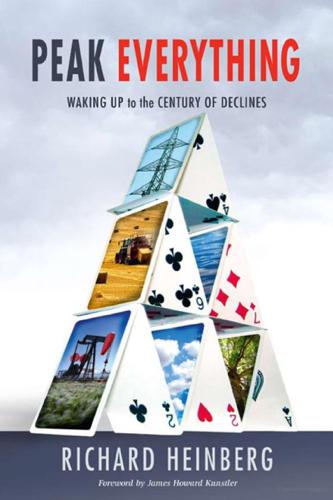
Peak Everything: Waking Up to the Century of Declines
by
Richard Heinberg
and
James Howard (frw) Kunstler
Published 1 Sep 2007
Another positive trend worth noting: in the Northeast US, where the soil is acidic and giant agribusiness has not established as much of a foothold as elsewhere, the number of small farms is increasing. Young adults — not in the millions, but at least in the hundreds — are aspiring to become Permaculture or organic or Biointensive farmers. Farmers markets and community-supported agriculture farms (CSAs) are established or springing up throughout the region. This is also somewhat the case on the Pacific coast, although much less so in the Midwest and South. What will it take to make these tentative trends the predominant ones? Among other things we will need good, helpful policies.
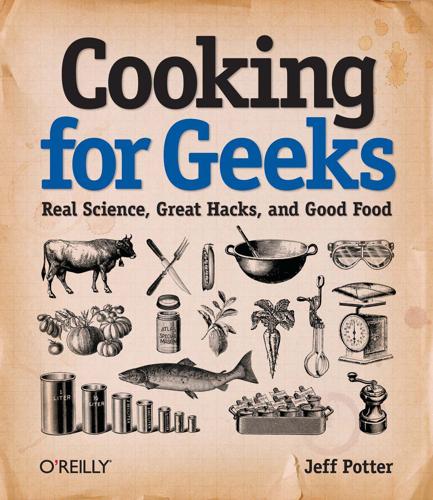
Cooking for Geeks
by
Jeff Potter
Published 2 Aug 2010
Locally grown veggies combined with a minimum of transportation and sold unpackaged are about as good as you can get for the environment, and they’re about as good as you can get for yourself. Look for a farmers’ market in the summer (or if you’re lucky enough to live in California, year-round). Farmers’ markets are a great way to really understand where your food is coming from. Plus, your local economy will thank you. You can also subscribe to a CSA (community-supported agriculture) share, where every week or two you receive a box of local and seasonal produce. It’s a great way to challenge yourself in the kitchen, because invariably something unfamiliar will show up in your CSA share, or you’ll find yourself with 10 pounds of spinach and be looking for something new to do with it.
…
"iSi Whippers") Crème Brûlée, Quinn’s, Blowtorches for crème brûlée Crepes, Unitaskers cross-contamination of foods about, How to Prevent Foodborne Illness Caused by Parasites cutting boards and, Cutting boards food allergies and, Cooking Around Allergies freezing meats and, Kitchen Equipment crosslinks aging animals and, 154°F / 68°C: Collagen (Type I) Denatures defined, 154°F / 68°C: Collagen (Type I) Denatures mechanical agitation and, Gluten CSA (community-supported agriculture), Seasonal Method curculin, Combinations of Tastes and Smells curry powder, Reading Between the Lines cutting boards, Cutting boards D dairy products allergies to, Substitutions for Common Allergies Almond Flan, Seasonal Method Beurre Noisette Ice Cream, 356°F / 180°C: Sugar Begins to Caramelize Visibly carrageenan in, Making gels: Carrageenan Cocoa-Goldschläger Ice Cream, Making dusts fats in, Whipped Cream Gelled Milk with Iota and Kappa Carrageenan, Making gels: Carrageenan Quinn’s Crème Brûlée, Blowtorches for crème brûlée substitutions for allergies, Substitutions for Common Allergies S’mores Ice Cream, Liquid Smoke: Distilled Smoke Vapor Yogurt, Umami (a.k.a.

Revolution at Point Zero: Housework, Reproduction, and Feminist Struggle
by
Silvia Federici
Published 4 Oct 2012
This is not a utopia, but a process already under way in many parts of the world and likely to expand in the face of a collapse of the world financial system. Governments are now attempting to use the crisis to impose stiff austerity regimes on us for years to come. But through land takeovers, urban farming, community-supported agriculture, through squats, the creation of various forms of barter, mutual aid, alternative forms of healthcare—to name some of the terrains on which this reorganization of reproduction is more developed—a new economy is beginning to emerge that may turn reproductive work from a stifling, discriminating activity into the most liberating and creative ground of experimentation in human relations.

The Microbiome Solution
by
Robynne Chutkan M.D.
Published 5 Aug 2015
But since much of what’s available in the supermarket is full of chemicals and devoid of any real nutrients, taking control of what we eat and making sure it comes from nature, not a factory, strikes me as a good idea. I’m fortunate to live in Washington, D.C., where farmers’ markets and community supported agriculture (CSA) shares are plentiful, so moving to an actual farm may seem a little extreme. My real motivation is that I want my daughter to grow up dirty, literally—as in easy on the soap and shampoo, heavy on the mucky animal chores. I shared her saga of antibiotic misadventure in my first book, Gutbliss.

Shadow Work: The Unpaid, Unseen Jobs That Fill Your Day
by
Craig Lambert
Published 30 Apr 2015
In essence, the system realizes Clarence Saunders’s vision of a Foodelectric store, seventy years after he propounded the idea. Ironically, another feature of grocery shopping in the twenty-first century harkens all the way back to the beginnings of the grocery-buying experience in America. Farmers’ markets and community-supported agriculture, or CSA, in which customers pay a farmer before the growing season for a share of the crops harvested over the summer, echo the public markets of the colonial era. The technology is low, and farmers’ markets remove the layers of middlemen from the food-buying process. These middlemen have become a kind of food chain in their own right.
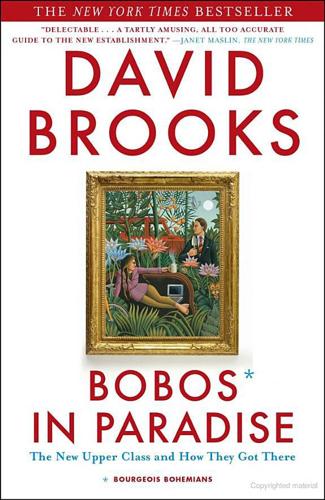
Bobos in Paradise: The New Upper Class and How They Got There
by
David Brooks
Published 1 Jan 2000
And this does seem to be a pretty accurate reflection of local priorities. Burlington boasts a phenomenally busy public square. There are kite festivals and yoga festivals and eating festivals. There are arts councils, school-to-work collaboratives, environmental groups, preservation groups, community-supported agriculture, antidevelopment groups, and ad hoc activist groups. The result is an interesting mixture of liberal social concern and old-fashioned preservation efforts to ward off encroaching modernism and, most important, development. And this public square is one of the features that draws people to Latte Towns.

River Cottage Every Day
by
Hugh Fearnley-Whittingstall
Published 2 Jan 2009
The more shoppers choose this kind of fresh produce over imported out-of-season exotics (especially ones that have traveled by air), the more supermarkets will commit to supporting the farmers who are ready and willing to supply the vast majority of the vegetables we need. Having said that, there is another way to get a regular supply of top-quality vegetables. If you’re not a customer already, I would heartily recommend giving a farm-box scheme a go (called a Community Supported Agriculture, or CSA, plan in the States). Here, you sign up for a weekly delivery from an organic farm, taking whatever fruits and vegetables are in season at the time. We sign up for a farm-box delivery at home during the colder months (my bid for self-sufficiency in winter vegetables is improving every year, but I still haven’t got it licked).

The People's Platform: Taking Back Power and Culture in the Digital Age
by
Astra Taylor
Published 4 Mar 2014
Why not resurrect the vision of an advertising-independent search engine that initially inspired Google’s founders, or launch a cooperatively owned version of iTunes or Netflix (perhaps modeled on successful institutions such as New Day Films, a documentary distribution collective that has survived for four decades), or start online associations based on Community Supported Agriculture (known as CSAs) that allow readers to purchase advance shares to fund local newsgathering? There are plenty of inventive financial arrangements that could put sustainability and civic responsibility front and center, yet so far they mostly go untried. In the digital realm, who stands for the public interest?
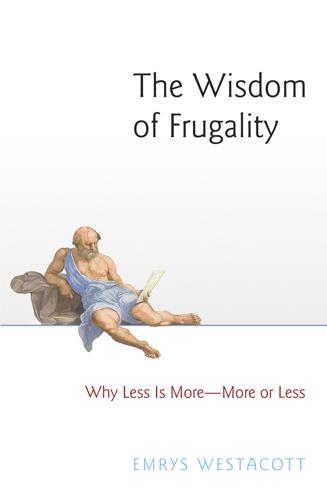
The Wisdom of Frugality: Why Less Is More - More or Less
by
Emrys Westacott
Published 14 Apr 2016
So given a choice, they will buy local apples rather than apples shipped from thousands of miles away, and they will look to eat what is in season where they live insofar as this is possible. Obviously, locavores differ in how seriously and rigorously they apply these principles, but the thinking behind the philosophy is common to all. Locally produced food, they argue, is usually better quality since it is fresh. Because it is often produced on a small scale by Community Supported Agriculture (CSAs), organic farms, community gardens, or backyards, it is healthier and more trustworthy than what comes from industrial agriculture, where fruit and vegetables are drenched in pesticides and animals are pumped full of steroids and antibiotics. It typically requires less energy to produce and transport.
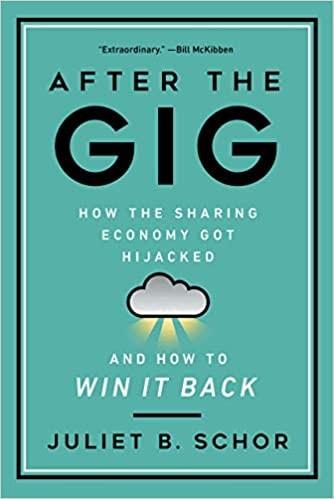
After the Gig: How the Sharing Economy Got Hijacked and How to Win It Back
by
Juliet Schor
,
William Attwood-Charles
and
Mehmet Cansoy
Published 15 Mar 2020
The dynamics of Olio differ from conventional donations to food banks, as the offerings are typically already prepared foods—sandwiches, baked goods, etc. This also reduces its distributional effect across income groups. 47. Fremstad (2017). This amounted to a 1.7 percent reduction. Chapter 5 1. A farm share is a portion of a farm’s produce, via an arrangement called Community Supported Agriculture, or CSA. In a CSA, members pay an amount in advance of the growing season and get weekly allotments of food as it is harvested. 2. Schor (2010, chap. 2). 3. Individual case studies are written up in a variety of our papers. These include “Distinction at Work: Status Practices in a Community Production Environment” (Attwood-Charles and Schor 2019 [makerspace]); “We Are Creatives: Symbolic Inefficacy and the Decoupling of Meaning from Practice” (Attwood-Charles 2019b [makerspace]); “Creativity as Organizational Myth and Practice” (Attwood-Charles 2020 [makerspace]); “Homemade Matters: Logics of Opposition in a Failed Food Swap” (Fitzmaurice and Schor 2018 [food swap]); “The Pedagogy of Precarity: Laboring to Learn in the New Economy” (Carfagna 2017 [open learning]); and “New Cultures of Connection in a Boston Time Bank” (Dubois, Schor, and Carfagna 2014 [time bank]).
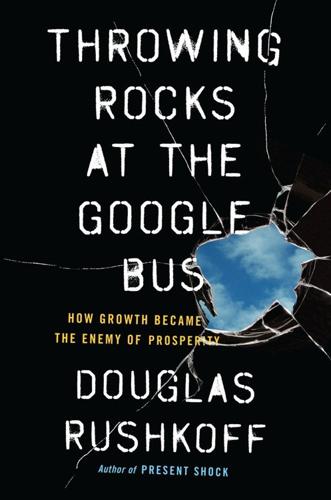
Throwing Rocks at the Google Bus: How Growth Became the Enemy of Prosperity
by
Douglas Rushkoff
Published 1 Mar 2016
Instead of simply resisting disruption, the hybrid company embraces it while also staking a real but limited claim on that disruption’s becoming the new normal. What might some of these strategies look like moving forward? Consider supermarket chains, which are increasingly threatened by local food shares, community-supported agriculture (CSA), and growing discontent with Big Agra. The traditional corporate response to this conundrum is Whole Foods: a large, publicly traded company that attempts to provide consumers with organic products at scale. Problem is, “certified organic”—an appellation itself corrupted by corporate agriculture’s lobbying of the Department of Agriculture—rarely means food from small or local farms.

Food and Fuel: Solutions for the Future
by
Andrew Heintzman
,
Evan Solomon
and
Eric Schlosser
Published 2 Feb 2009
At the retail meat case and in commercial or institutional dining rooms, it is often unclear whether meat was provincially or federally inspected, and it is difficult to discover where it was slaughtered and processed. Many Canadians prefer to buy meat from locally produced livestock, and there is growing interest in organic and natural meat products, community-supported agriculture, and alternative farming practices. This trend should reinforce the role of small-scale, locally oriented slaughter plants in the commodity chain. The friendly, small-town butcher, operating a small provincially inspected plant, provides a valued alternative to national chain stores and large scale meat-packing plants.
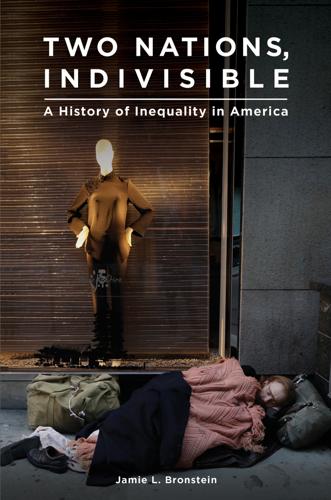
Two Nations, Indivisible: A History of Inequality in America: A History of Inequality in America
by
Jamie Bronstein
Published 29 Oct 2016
For example, the living wage movement targets the minimum wage in individual cities, and “the devolution of welfare programs to the state level betters allows for grass-roots movements to make an impact and gives activists a critical sense of efficacy.”90 Borrowing from a vibrant tradition in Latin America, some communities in the United States are experimenting with programs like time banking, which enable participants simultaneously to build a sense of solidarity and to trade services with each other; community supported agriculture programs; or community producers’ or consumers’ cooperatives.91 Although it would do the most to reduce inequality, raising taxes on the nation’s wealthiest seems the least likely tangible scenario. Studies show that even as Americans express discontentment with rising inequality, they are squeamish about the government expanding taxes—even taxes on the wealthy—or establishing admittedly redistributive government programs.92 It is difficult to communicate to people that economic inequality undermines democracy itself, and that, at such a point, “reasonable envy” has to come into play to restore the political balance.93 But Republicans’ willingness to threaten government shutdown or even to countenance possible default over the debt ceiling shows that in general, negotiations about economic issues linked to equality—education, infrastructure, research and development, and health care—are off the table.94 Finally, the inequality problem might be partially addressed by regulating labor markets through higher minimum wages or even maximum wages.
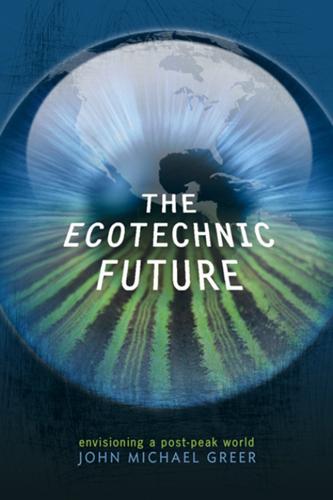
The Ecotechnic Future: Envisioning a Post-Peak World
by
John Michael Greer
Published 30 Sep 2009
Far more likely is a situation in which soaring fossil fuel prices cascade down the food chain, turning industrial farms and their distribution networks into economic basket cases propped up by government subsidies, sky-high food prices and trade barriers that keep other options out of the economic mainstream. Since people still need to eat, a future of this sort will likely accelerate the rise of microfarms and market gardens and the co operatives, farmer’s markets and community-supported agriculture schemes that provide food distribution outside the official economy. This backyard agriculture will have to use minimal fossil fuel inputs 105 106 T he E cotechnic F u t u re and rely on local distribution, since fuel costs will put long-distance transport out of reach. It will have to focus on intensive production from very small plots, since most acreage large enough for industrial farming will already be occupied by industrial farms, and thus hard to come by.
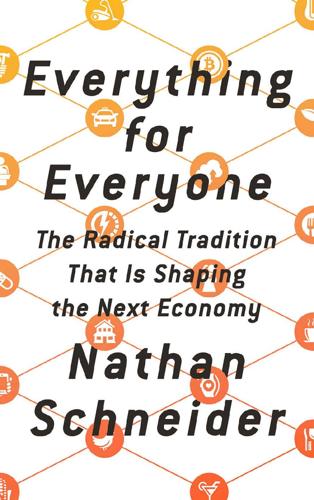
Everything for Everyone: The Radical Tradition That Is Shaping the Next Economy
by
Nathan Schneider
Published 10 Sep 2018
People make these programs because they need them, not because they think they can manipulate someone to want them. Instead of relying on rich kids in a Googleplex somewhere, slow computing works best when we’re employing people like Jamie McClelland to adapt open tools to local needs. He’s my farmer; May First is my community-supported agriculture, my CSA. Still, to those interested in some consciousness-raising about the machines with which we spend so much of our lives, there’s a need for more than my acts of piety—there’s a need for better business models, models accountable to users more than the whims of capital markets, that reward contributions to the commons more than tricks that make data of public import artificially scarce and the data of our private lives surreptitiously profitable.

This Changes Everything: Capitalism vs. The Climate
by
Naomi Klein
Published 15 Sep 2014
While visiting Red Hook, Brooklyn, one of the hardest hit neighborhoods, I stopped by the Red Hook Community Farm—an amazing place that teaches kids from nearby housing projects how to grow healthy food, provides composting for a huge number of residents, hosts a weekly farmer’s market, and runs a Community Supported Agriculture (CSA) program, getting all kinds of produce to people who need it. Not only was the farm improving the lives of people in the neighborhood, it was also doing everything right from a climate perspective—reducing food miles; staying away from petroleum inputs; sequestering carbon in the soil; reducing landfill by composting.
…
Mijin, 216 Chad, 270 Chamber of Commerce, U.S., 31, 48 chaos theory, 267 Chappell, Ronnie, 228 charitable foundations, 205–6, 210n extractive industries and, 197–98 Charter of Rights and Freedoms, Canadian, 371 Chávez, Hugo, 179, 182 Chen Jiping, 351 Chesapeake Energy, 312, 356–57 Chevron, 111, 129, 221, 291 Ecuador’s lawsuit against, 309, 378 Gorgon project of, 145–46 green groups funded by, 196, 217 Niger Delta operations of, 308 Pungesti shale gas project of, 298–99, 347, 404 Richmond refinery of, 321, 402 Chicago, University of, 81 Chilcotin River, 345 children, impact of environmental toxins on, 427–29 Childs, Mike, 250 Chile, 9, 454, 464 Chilko River, 345 China, 5, 24, 55, 58, 79, 82, 88n, 451 air pollution in, 17–18, 23, 350, 351 anti-coal movement in, 300, 350–52 carbon emissions from, 409–10, 411, 412 Central Committee, Communist Party, 133 coal exports to, 234 coal use in, 81–82, 83 coolant factories in, 219–20 Copenhagen nonbinding agreement signed by, 12 as creditor, 180 economic growth in, 351–52 as emerging market, 20 environmental contamination in, 23, 83, 154 export-led development in, 81 fast-growing economy of, 40, 153 human rights issues in, 351–52 peasant uprisings in, 350–51 renewable energy programs in, 352 solar energy and, 66, 68, 69–70, 72 wealth in, 114 WTO challenges brought against, 64–65, 68, 70 WTO challenges brought by, 65 WTO membership of, 76 Chisholm, Sallie, 267 Chrétien, Jean, 83 Chrysler, 67, 68 Chukchi Sea, 375–76 CIA, 53 civil disobedience, 139 civil rights movement, 204–5, 450, 453 Clarkson, Thomas, 463 Clatskanie, Oreg., 349 clear-cutting, 296, 304, 310 Climate Action Network, 149 climate change, 73, 110, 165, 176, 177, 230, 249 acceptable risk and, 335 astronaut’s-eye view of, 284–90, 296 centrist organizations and, 198–201 community and, 364–65 computer models of, 270–71 corporate deregulation and, 20 defining of, 210 democracy and, 363–64 developing world on, 75 disasters and, 2–3, 17, 102–3, 154, 406, 465 fracking and, 199 as transformative force, 7, 8, 152–60 Indigenous rights and, 380–84, 385 individual vs. corporate conservation in, 116–18 marine infertility and, 433–35 mitigation of, 134 negotiations on, 11 past and future generations in, 158–59 as planetary emergency, 6, 7, 15, 17, 18, 449–50, 459–60 planetary exodus as solution to, 288–89 and power relation between humans and earth, 175 as result of cumulative emissions, 21, 40, 56, 175, 409–10, 416 roots of, 159–60 sacrifice zones and, 310–11, 315 “safe” limit of, 12–13 tipping points for, 14, 412 2 degrees Celsius boundary in, 87–88, 89, 150, 354, 456 wealth creation and, 46–52 weather patterns and, 269 climate change denial, 2–5, 26, 43, 91, 119, 282–83, 394, 407, 451 economics as factor in, 3, 45–46, 59–60 extractive industries’ funding of, 44–45, 149, 198 increase in, 35 partisan approach to, 35–36 right-wing, 31–63, 154, 178 socioeconomic privilege and, 46–52 technological miracles and, 3 Climate of Corruption (Bell), 33 climate debt, 5, 7, 457 owed to developing world, 5, 7, 40, 387, 408–18 owed to Indigenous peoples, 387, 388–99, 408 seen as politically toxic, 414 Climate Depot, 32, 45 Climategate, 41 climate justice, see climate debt climate manipulation, see geoengineering climate movement: coming of age of, 11–12 deregulated capitalism and, 20 economic justice and, see climate debt growing power and interconnectedness of, 451–52 historical precedents for, 452–57, 459–61 Keystone XL protests and resurgence of, 139–40 lack of sustained and populist, 157 moral imperative in, 336, 386–87, 464 and need for viable economic alternatives to extraction industries, 349, 398, 399, 400–401, 403, 413–18 origins of, 73–75 see also Blockadia climate science, 46, 59, 127, 152, 158 climate treaty negotiations, 11, 77–80, 411 see also emission reduction Clinton, Bill, 83–85, 213, 231–32 Clinton administration, carbon trading proposed by, 218 Clinton Global Initiative annual meeting of 2006, 231 Clodumar, Kinza, 165 Clorox, 356, 357 cloud brightening, 258 cloud seeding, 279 Club of Rome, 185–86 CNN, 45 Coal & Climate Summit, 200 coal, 102, 128, 143, 159, 176, 214, 224 capitalism and, 175, 176 collapsing U.S. market for, 319–20 exporting of, 144n, 301, 320, 322, 349, 352, 362, 374, 376 lignite, 136 as “portable climate,” 174 rail transport of, 234, 362, 389, 397 water power vs., 171–73 coal-fired power plants, 3, 67–68, 81–82, 83, 97, 136–39, 141, 200, 208, 236, 247–48 global campaign against, 319–20, 348–49, 350–52, 365 public utilities and, 100, 196 coal industry, 197, 300–301 opposition to, see anti-coal movements political and economic power of, 316, 321 see also extractive industries coal mining, 145, 398 in Appalachia, 309, 353 in Montana, 320, 342–43, 346, 370, 388–93, 395, 397, 445 mountaintop removal in, 2, 303, 309, 310, 329, 353 water supply contamination from, 332 coal-powered economies, 88 Coates, Ta-Nehisi, 415 Cobenais, Marty, 318–19, 332 Cochabamba, Bolivia, 444n Cohen, Nick, 156 Cold War, 15, 42, 43, 74, 261 collective action, 36 collective sacrifice, 16–17 colleges and universities: divestment movement and, 354–55, 401 renewable energy investment by, 401–2 Colombia, 202, 348, 376–77 colonialism, 154, 370, 414–16 coal and, 173, 176 extractivism and, 169–70 Industrial Revolution and, 171, 175, 457 Scientific Revolution and, 170–71 Colorado, 52, 357n Colorado School of Public Health, 428 Combes, Maxime, 304n, 317–18 Committee for a Constructive Tomorrow, 45 Common Sense (Paine), 314 communism, 20, 39, 42, 44, 177 communities, 106 building of, 92 climate change and, 364–65 renewable energy in, 131–32, 133 see also worldview, communitarian Community Supported Agriculture (CSA) programs, 405 compassion, 62–63, 462 Competitive Enterprise Institute, 32, 45, 411 complexity, 267, 290 composting systems, 108 computer models, of climate change, 270–71 Conant, Lionel, 380 Confederated Tribes of the Umatilla Indian Reservation, 319 Conference Board of Canada, 145 Congo, 220 ConocoPhillips, 226, 227–28, 246 Conservation Fund, 196, 205 Conservation International, 84, 189, 196, 205–6, 209, 211–12 Conservative Party (Canadian), 36 Constitution, Canadian, 371 construction, green, 90 consumer lifestyles, 2, 75, 116–17 consumption, 116 decrease in, 90 excess, 85, 91, 92, 93, 210, 412, 413 green, 211–13, 252 container ships, 76, 79 Conway, Erik, 42 Cook, James, 266 Cook, Katsi, 419 coolants, 219–20 “Cool Dudes” (McCright and Dunlap), 46–47 Coon, David, 374 co-ops: energy, 130, 131–32 worker-run, 122–23, 133 Coos Bay, Oreg., 349 Copenhagen Climate Summit of 2009, 11–14, 34, 150, 262, 451 copper, 91n, 296 coral, coral reefs, 301, 348, 434 Corexit, 432 Cornell University, 143, 217, 317 corn ethanol, 239, 240 corporate donors, 83, 210n corporations, 25 centralization under, 179 crisis exploited by, 8 democracy vs., 7 deregulation of, 19, 20, 72, 142, 154, 210 disaster prevention at, 51–52 environmental groups’ cooperation with, 196, 206–11 freedom from regulation for, 19 free speech for, 151 goals of private, 129–30 ideology of, 75 impact of climate change on, 49 Indigenous peoples vs., 221–23 natural world vs., 60–61 political power of, 199, 124–26, 141–52 right-wing think tanks funded by, 44, 50 taxes avoided by, 115 USCAP and, 226–28 Correa, Rafael, 180–81, 410–11 corruption, of government regulators, 333–34 Cosbey, Aaron, 70 Costa Rica, 348 Coste, Torrance, 363 “Cowboys and Indians alliance,” 302, 318–19, 322–23, 346 crash of 1929, 88 Crawford, Julia Trigg, 361 Crompton, Tom, 60 crops, 9, 34, 57 crowdfunding, 198 Crow Reservation, 389, 397 Crutzen, Paul, 261–62 Cuadrilla, 130 cultural cognition, 36, 44–45, 59, 63, 186 Culture of Narcissism (Lasch), 117 Czechoslovakia, 178 Czech Republic, 42–43, 144, 348 Dai, Aiguo, 272, 275 Daily Mail, 5454 Dallas, Tex., 329 Daly, Herman, 173 dams, 180, 183, 202 Daniel, Patrick, 331–32 dark money, 44 Darling, Jay Norwood “Ding,” 185 Dauphin Island Sea Lab, 433–34 David, Ned, 247 Davis, David Brion, 463 Dayaneni, Gopal, 448 Day One, 391 DDT, 185, 201, 203, 207 de Boer, Yvo, 87 decade zero, 24, 143 Dediu, Doina, 344 deep ecology, 75 deepwater drilling, see offshore drilling, deepwater Defense Department, U.S., 113 deforestation, 202 degrowth strategies: selective, 93–95 for wealthy nations, 88, 89 Delaware River Basin, 346 Delgamuukw v.

Affluenza: The All-Consuming Epidemic
by
John de Graaf
,
David Wann
,
Thomas H Naylor
and
David Horsey
Published 1 Jan 2001
Like the rest of the country, Harmony residents are victims of an economy that doesn’t always “get it.” Recently, they caught employees of the recycling company red-handed—mixing carefully sorted materials together with trash bound for the landfill. The group also experiments with more innovative activities, like community-supported agriculture. Since their own garden is still evolving, many in the neighborhood subscribe to a produce service from a local farmer who delivers eight or ten bushel baskets of produce to the neighborhood every week. This enables J. P., the farmer, to know at the beginning of the growing season how much to plant.

Early Retirement Extreme
by
Jacob Lund Fisker
Published 30 Sep 2010
If you can't have chicken, at least get a fishing license and use your surplus worms or share them with others. There are always people who are into vermicomposting. All it takes to build a vermicomposter are two buckets and a drill. If you can't get access to land, and indoor hydroponics is too far-fetched, you could join a CSA (community-supported agriculture). Buying into a CSA seems rather expensive, though, and it may be cheaper to arrange your own "community" by asking friends if you can use some of their unused land to plant something. Many will be happy to let you pluck their oranges or apples to keep their lawn free of obstacles. Some engage in guerrilla gardening.
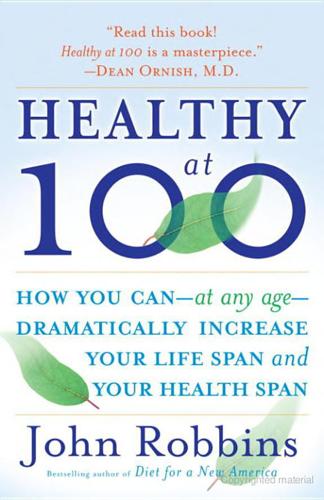
Healthy at 100: The Scientifically Proven Secrets of the World's Healthiest and Longest-Lived Peoples
by
John Robbins
Published 1 Sep 2006
You don’t have to count calories if you make every calorie count. Eat slowly, chew thoroughly, digest well. Eat just to the point of fullness without feeling stuffed. Remember that it takes twenty minutes for your stomach to register how full it is, so give it time. _____ Whenever possible, shop at local farmers’ markets or participate in community-supported agriculture, buying produce direct from the grower. Shop at local natural-foods stores, or at chains like Whole Foods, Wild Oats, and Trader Joe’s. Always read labels so that you can select foods with the most nutritious ingredients. Save money and packaging by buying in bulk. Don’t buy or eat anything that contains partially hydrogenated oil.
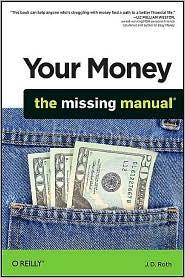
Your Money: The Missing Manual
by
J.D. Roth
Published 18 Mar 2010
It's your money—ask for it. Buy from produce stands and farmers markets. During the summer months, produce stands and farmers markets offer fresh, local food at excellent prices. Even better, these kinds of places usually don't have a lot of impulse items to tempt you. Also look at community-supported agriculture (CSA) programs, which let you "subscribe" to fresh produce from a local farm (see www.localharvest.org for more info). Waste not. One of the best ways to save money on food is to not let it go to waste. According to various estimates, Americans throw away 12–25% of their food. So if you spend $400 on groceries every month, you may be able to save $50 to $100 simply by never throwing food away.
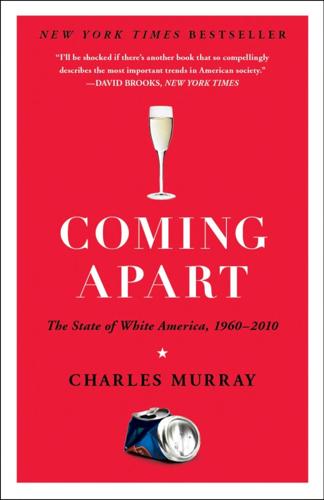
Coming Apart: The State of White America, 1960-2010
by
Charles Murray
Published 1 Jan 2012
Burlington, Vermont, is an example of a certain kind of small city that David Brooks calls “Latte Towns,” enclaves of affluent and well-educated people, sometimes in scenic locales such as Santa Fe or Aspen and sometimes in university towns such as Ann Arbor, Berkeley, or Chapel Hill. Of Burlington, Brooks writes: Burlington boasts a phenomenally busy public square. There are kite festivals and yoga festivals and eating festivals. There are arts councils, school-to-work collaboratives, environmental groups, preservation groups, community-supported agriculture, antidevelopment groups, and ad hoc activist groups.… And this public square is one of the features that draw people to Latte Towns. People in these places apparently would rather spend less time in the private sphere of their home and their one-acre yard and more time in the common areas.12 Attendance at city council meetings in Latte Towns is high and residents who willingly take part in local politics are plentiful.
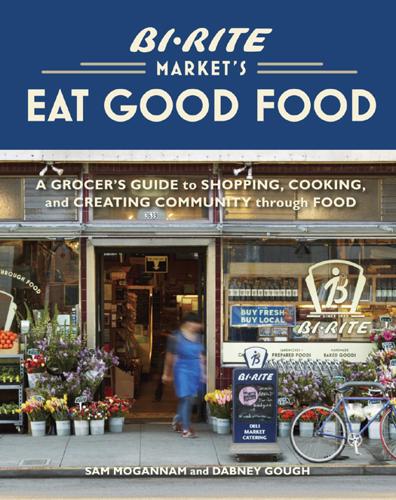
Bi-Rite Market's Eat Good Food: A Grocer's Guide to Shopping, Cooking & Creating Community Through Food
by
Sam Mogannam
and
Dabney Gough
Published 17 Oct 2011
We have found other ways to support producers, such as our unique arrangement with Soul Food Farm. As a burgeoning farm, they had the best possible problem: they had more demand for their gorgeous eggs than they could supply. To scale up, they needed capital. So we loaned it to them, repayable through a steady supply of eggs and chickens for the next year. Sort of like a community-supported agriculture (CSA, or “farm shares”) arrangement, but with bigger volume and a single customer—us! And everyone benefited from it—Soul Food Farm, our guests, and Bi-Rite. Over the years, we realized how important it was for us to facilitate these relationships between our staff, our vendors, and our guests—each one interdependent on the other for success.
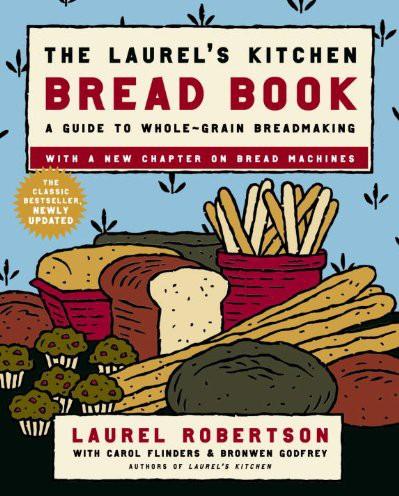
The Laurel's Kitchen Bread Book: A Guide to Whole-Grain Breadmaking
by
Laurel Robertson
,
Carol Flinders
and
Bronwen Godfrey
Published 2 Jan 1984
But certain innovations took hold and never went away—not, typically, as mass movements, and not in a big public way, but quietly and steadily, moved along lovingly by individuals whose dedication seems to get a little deeper by the year. The organic gardening movement, for instance, has unfurled into a global network of activists who advocate a wide spectrum of inter-connected programs like Sustainable Agriculture, Community Supported Agriculture, cooperative urban gardens, and the use of fresh locally-grown produce in school lunches, and who defend the rights of small farmers everywhere, opposing vehemently the use of genetically modified organisms and the patenting of plant and animal species. Whole-grain bread is another of those new/old “Well, whyever not?”

Seeds of Hope: Wisdom and Wonder From the World of Plants
by
Jane Goodall
Published 1 Apr 2013
“genetic engineering has not contributed to yield increase” Doug Gurian-Sherman, “Failure to Yield: Evaluating the Performance of Genetically Engineered Crops,” Union of Concerned Scientists, April 2009, http://www.ucsusa.org/assets/documents/food_and_agriculture/failure-to-yield.pdf. 46. “community-sponsored agriculture (CSA) programs” “Community Supported Agriculture,” LocalHarvest, accessed July 30, 2013, http://www.localharvest.org/csa/. 47. “four thousand listed in its database” Ibid. CHAPTER 16 1. “representing at least a million US households” “2011 Late Summer Garden Trends Report,” Garden Writers Association, accessed August 21, 2013, http://www.gardenwriters.org/gwa.php?
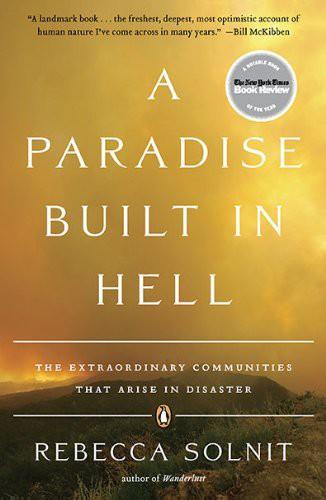
A Paradise Built in Hell: Extraordinary Communities That Arise in Disaster
by
Rebecca Solnit
Published 31 Aug 2010
They do not create these gifts, but they are one avenue through which the gifts arrive. Disasters provide an extraordinary window into social desire and possibility, and what manifests there matters elsewhere, in ordinary times and in other extraordinary times. Most social change is chosen—you want to belong to a co-op, you believe in social safety nets or community-supported agriculture. But disaster doesn’t sort us out by preferences; it drags us into emergencies that require we act, and act altruistically, bravely, and with initiative in order to survive or save the neighbors, no matter how we vote or what we do for a living. The positive emotions that arise in those unpromising circumstances demonstrate that social ties and meaningful work are deeply desired, readily improvised, and intensely rewarding.

Worn: A People's History of Clothing
by
Sofi Thanhauser
Published 25 Jan 2022
One of these first profiles I wrote was of a woman who was helping people organize around alternatives to the industrial food system. She had worked to get fresh produce gleaned from local farms into the school cafeterias. She had started a nonprofit initiative to support farmers starting CSAs (community-supported agriculture). She was launching a magazine to tell stories about local food producers. During our interview, we talked for a long time about the industrial food system. This is a system that has much in common with the contemporary garment industry. It carries goods across long distances. It relies on a labor pool of agricultural workers who, like garment workers, often toil in dangerous conditions without hope of union protections.

Imaginable: How to See the Future Coming and Feel Ready for Anything―Even Things That Seem Impossible Today
by
Jane McGonigal
Published 22 Mar 2022
The medicine bag is a reusable tote bag with a unique barcode printed on the fabric that links the bag to your health care profile. Once a week, you can fill the bag with whatever fresh produce you want, for free. Any fruit, any vegetable—at the grocery store, at a farmers’ market, at a corner or roadside fruit stand—you want it, you got it. You could have chosen to get a community-supported agriculture (CSA) box delivered weekly, but you picked the bag instead. You liked the idea of going on your own version of a “supermarket sweep” up and down the produce aisle, grabbing as much as you want without having to worry about or even check the price. Your medicine bag is part of your health insurer’s new program to get primary care doctors to prescribe fresh fruits and vegetables to as many people as possible.
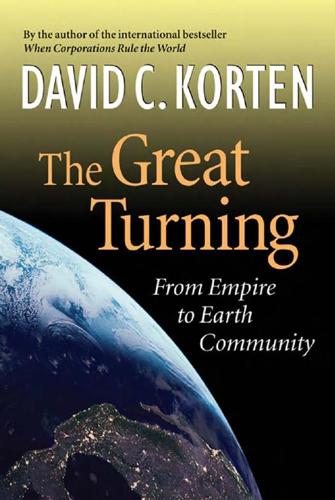
The Great Turning: From Empire to Earth Community
by
David C. Korten
Published 1 Jan 2001
Such efforts might seem futile if not for the fact that communityrooted, human-scale, values-based, independent businesses constitute by far the majority of all businesses, provide most of the jobs, create nearly all new jobs, and serve as the primary source of technological innovation.5 They include businesses of all sorts, from bookstores to bakeries, land trusts, manufacturing facilities, software developers, organic farms, farmers’ markets, community-supported agriculture initiatives, restaurants specializing in locally grown organic produce, worker co-ops, community banks, suppliers of fair-traded coffee, independent media outlets, and many more. POLITICAL TURNING Other citizen initiatives are democratizing the structures of government, promoting more active citizen participation in political life, opening the political process to a greater diversity of voices and parties, and shifting public priorities in favor of people, families, communities, and the planet.
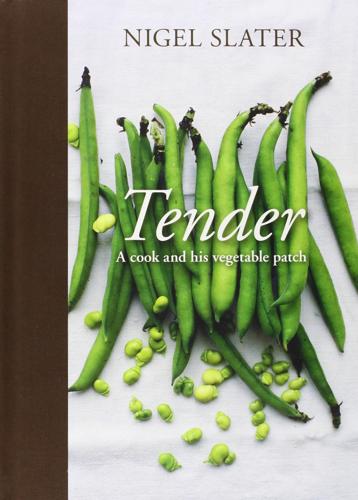
Tender: A Cook and His Vegetable Patch
by
Nigel Slater
Published 14 Sep 2009
The allotments referred to throughout this book are small parcels of land leased to private citizens in England (and Europe) by local government entities for the purpose of growing food crops. Allotments differ from community gardens in that they are not worked by a group of people, but by the individual to whom the land is leased. The organic-box program in the UK is equivalent to the US system known as Community Supported Agriculture, or CSA, in which farmers deliver their locally grown produce directly to consumers in a weekly box throughout the farming season. In this program, farmers offer a certain number of “shares” to the public; consumers purchase a share and in return receive a weekly produce delivery. The vegetable diaries and growing seasons reflect the experiences in the particular climate of a London garden.

Meat: A Benign Extravagance
by
Simon Fairlie
Published 14 Jun 2010
In the above, the FAO are describing a process of industrialization that has, in its own individual way, already taken place in the UK over the last 200 years and whose spread throughout the developing world they predict, endorse and promote. Today many people in Britain have misgivings about the industrialized agricultural system that we have inherited, and are trying to de-industrialize it through support for organic farming, local foods, real meat, community supported agriculture, animal welfare measures, and campaigns against GM, pesticides and junk food. To the FAO these are an indication that we in Britain, have reached the ‘post-industrial’ phase where, as they put it, ‘environmental and public health objectives take predominance’. The poorest in the developing world have no choice but to progress through three prior stages of industrialization and urbanization before they arrive at our state of grace, and even if they had the choice, that is what they would choose to do.
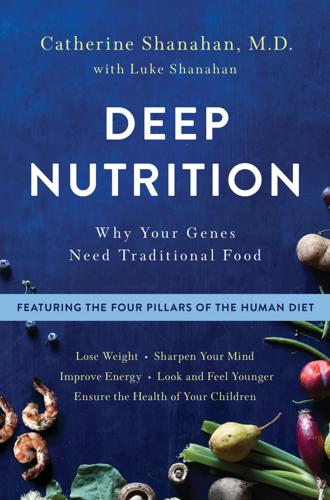
Deep Nutrition: Why Your Genes Need Traditional Food
by
Catherine Shanahan M. D.
Published 2 Jan 2017
www.RealMilk.com: Volunteer chapter leaders from the Weston A. Price foundation post sources of fresh dairy on this web site. www.SlowFoodUSA.org: Supports consumption of good, clean, and fair food. Members join local convivia. www.LocalHarvest.org: Interactive map for finding farmers markets, CSAs (Community Supported Agriculture), and events, including workshops for learning artesanal food production techniques. RECOMMENDED BRANDS LiveCulture Fermented Foods Real pickles: Bubbies Whole Dill Pickles Real saurkraut: Bubbies Saurkraut Kombucha: GT Dave Synergy (lower in sugars than most other kombuchas) Dairy Yogurt: Wallaby, Soneyfield, Organic Valley, Kalona Supernatural Cottage cheese: Kolona Supernatural, Organic Valley Cream cheese: Organic Valley Sour cream: Kolona Supernatural Cream: Kolona Supernatural, Organic Valley Pasture Raised Milk: Kolona Supernatural, Organic Valley Pasture Raised Butter: Kerrygold, Kolona Supernatural, Organic Valley Pasture Butter Cheese: Organic Valley, Dubliner (check Costco for great deals on Dubliner and other grass-fed or artisanal raw cheeses) Fish and Meats Liverwurst and bratwurst (surprisingly tasty): US Wellness Meats (exclusively online) Beef jerky: Nick’s Sticks Certified Paleo Grass-Fed Beef and Organ Meat (exclusively online) 100 percent grass-fed hotdogs: Applegate Naturals, Fork in the Road Wild sardines in extra virgin olive oil: Crown Prince, Wild Planet, King Oscar (bone in, for bone-building minerals) Kipper snacks, naturally smoked: Crown Prince Smoked oysters in olive oil: Crown Prince Grilled chicken strips: Applegate Naturals Sausage: Applegate Naturals Bacon: Applegate Naturals Miscellaneous Bone stock (chicken and beef, organic): Pacific Foods Sprouted pumpkin and sunflower seeds: Go Raw, Living Intentions (usually found in the freezer section) Sprouted almonds and flavored nuts: Living Intentions Sprouted grain bread: Ezekiel 4:9, Alvarado Street Bakery Mayo: Primal Kitchens (online and select stores) DOCTORS IN YOUR AREA Several webmasters maintain lists of doctors who are familiar with alternatives to the conventional USDA and ADA nutrition guidelines: Jimmy Moore’s List of Low Carb Doctors www.lowcarbdoctors.blogspot.com/ Robb Wolf’s Paleo Physicians Network www.paleophysiciansnetwork.com/ Chris Armstrong’s Primal Docs www.primaldocs.com/members/ SUGGESTED READING Abramson, John, Overdosed America: The Broken Promise of American Medicine, HarperCollins, 2004.
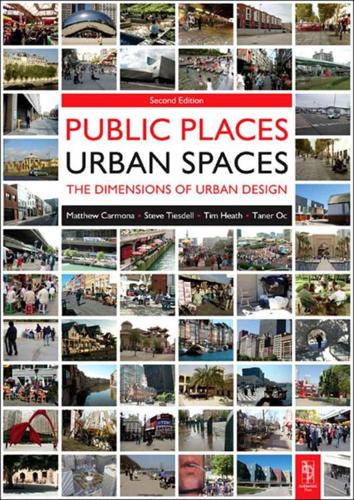
Public Places, Urban Spaces: The Dimensions of Urban Design
by
Matthew Carmona
,
Tim Heath
,
Steve Tiesdell
and
Taner Oc
Published 15 Feb 2010
Food supply and agriculture will also be affected – flying fresh fruit, vegetables, meats and fish thousands of miles will no longer be affordable, or even possible. To minimise travel for food, as Newman et al (2009: 136) suggest, ‘… localities will need to explore more local production such as “fifty mile menus” and community-supported agriculture.’ Involving sourcing the menu entirely from within a 50-mile radius of the restaurant, 50-mile menus aim to allow customers to enjoy local produce, to reduce food miles and to support local farmers. At present, this is an artificial discipline but it also indicates what might be needed for a more sustainable way of life.
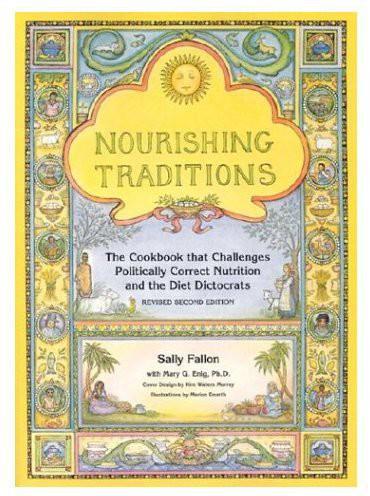
Nourishing Traditions: The Cookbook That Challenges Politically Correct Nutrition and The...
by
Sally Fallon
,
Pat Connolly
and
Mary G. Enig, Phd.
Published 14 May 1995
SWF Winter Root Medley Serves 4 4 parsnips, peeled and cut into sticks 4 turnips, peeled and cut into quarters 1 rutabaga, peeled and cut into chunks 3 tablespoons butter 3 tablespoons extra virgin olive oil In a heavy skillet, saute vegetables in butter and olive oil until tender and golden brown. Community Supported Agriculture (CSA) is a community-based organization of growers and consumers. The consumer households live independently but agree to provide direct, up-front support for the local growers who produce their food. . .the primary need is not for the farm to be supported by the community, but rather for the community to support itself through farming.